Yamaha CLP - 240 User Manual

C L P - 2 4 0 / 2 3 0
OWNER'S MANUAL
BEDIENUNGSANLEITUNG
MODE D’EMPLOI
MANUAL DE INSTRUCCIONES
Before using the Clavinova, be sure to read “PRECAUTIONS” on pages 6 -7.
Achten Sie darauf, vor Einsatz des Clavinova die “VORSICHTSMASSNAHMEN” auf Seite 6 -7 durchzulesen.
Avant d'utiliser le Clavinova, lire attentivement la section «PRECAUTIONS D'USAGE» aux pages 6 -7.
Antes de utilizar el Clavinova, lea las “PRECAUCIONES” que debe tener en cuenta en las páginas 6 -7.
IMPORTANT
—Check your power supply—
Make sure that your local AC mains voltage matches the voltage specified on the name plate on the bottom panel. In some areas a voltage selector may be provided on the bottom panel of the main keyboard unit near the power cord. Make sure that the voltage selector is set for the voltage in your area. The voltage selector is set at 240V when the unit is initially shipped. To change the setting use a "minus" screwdriver to rotate the selector dial so that the correct voltage appears next to the pointer on the panel.
For information on assembling the keyboard stand, refer to the instructions at the end of this manual.
WICHTIG
—Überprüfen Sie Ihren Netzanschluss—
Vergewissern Sie sich, dass die Spannung in Ihrem örtlichen Stromnetz mit der Spannung übereinstimmt, die auf dem Typenschild auf der Unterseite des Instruments angegeben ist. In bestimmten Regionen ist auf der Unterseite des Keyboards in der Nähe des Netzkabels ein Spannungswähler angebracht. Vergewissern Sie sich, dass der Spannungswähler auf die Spannung Ihres lokalen Stromnetzes eingestellt ist. Dieser Spannungswähler ist bei Auslieferung auf 240 V eingestellt. Sie können die Einstellung mit einem Schlitzschraubenzieher ändern. Drehen Sie dazu den Wählschalter, bis der Pfeil auf dem Instrument auf die richtige Spannung zeigt.
Weitere Informationen über die Montage des Keyboard-Ständers erhalten Sie in den Anweisungen am Ende dieses Handbuchs.
IMPORTANT
—Contrôler la source d'alimentation—
Vérifiez que la tension spécifiée sur le panneau inférieur correspond à la tension du secteur. Dans certaines régions, l'instrument peut être équipé d'un sélecteur de tension situé sur le panneau inférieur du clavier à proximité du cordon d'alimentation.
Vérifiez que ce sélecteur est bien réglé en fonction de la tension secteur de votre région. Le sélecteur de tension est réglé sur 240 V au départ d'usine. Pour modifier ce réglage, utilisez un tournevis à lame plate pour tourner le sélecteur afin de mettre l'indication correspondant à la tension de votre région vis à vis du repère triangulaire situé sur le panneau.
Pour obtenir des informations sur l'assemblage du support du clavier, reportez-vous aux instructions à la fin de ce manuel.
IMPORTANTE
—Verifique la alimentación de corriente—
Asegúrese de que tensión de alimentación de CA de su área corresponde con la tensión especificada en la placa de características del panel inferior. En algunas zonas puede haberse incorporado un selector de tensión en el panel inferior de la unidad del teclado principal, cerca del cable de alimentación. Asegúrese de que el selector de tensión esté ajustado a la tensión de su área. El selector de tensión se ajusta a 240V cuando la unidad sale de fábrica. Para cambiar el ajuste, emplee un destornillador de cabeza "recta" para girar el selector de modo que aparezca la tensión correcta al lado del indicador del panel.
Para información sobre el montaje del soporte del teclado, consulte las instrucciones al final de este manual.
ENGLISH
DEUTSCH
FRANÇAIS
ESPAÑOL
EN
DE
FR
ES
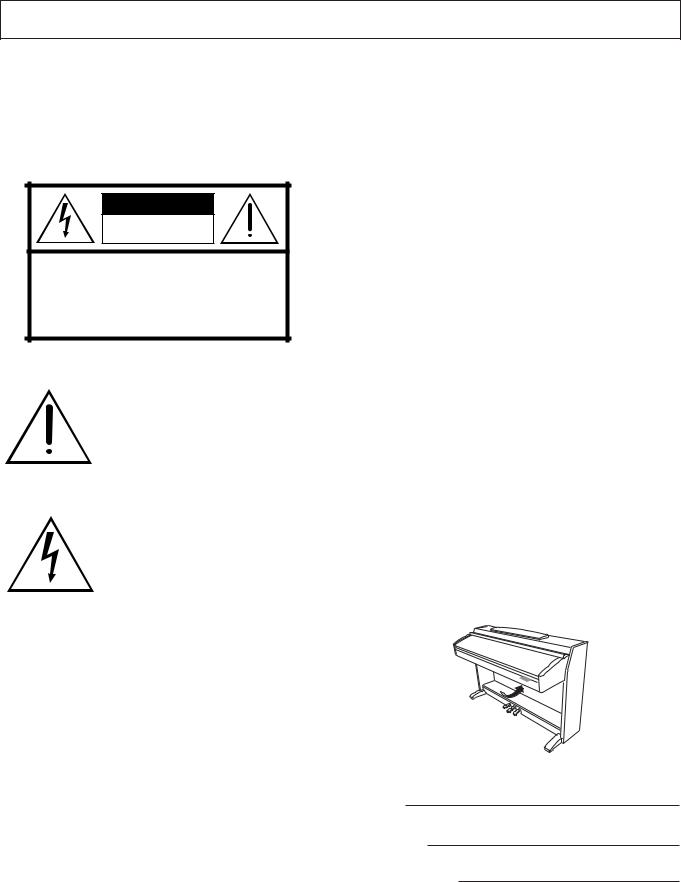
SPECIAL MESSAGE SECTION
PRODUCT SAFETY MARKINGS: Yamaha electronic products may have either labels similar to the graphics shown below or molded/stamped facsimiles of these graphics on the enclosure. The explanation of these graphics appears on this page. Please observe all cautions indicated on this page and those indicated in the safety instruction section.
CAUTION |
RISK OF ELECTRIC SHOCK |
DO NOT OPEN |
CAUTION: TO REDUCE THE RISK OF ELECTRIC SHOCK. |
DO NOT REMOVE COVER (OR BACK). |
NO USER-SERVICEABLE PARTS INSIDE. |
REFER SERVICING TO QUALIFIED SERVICE PERSONNEL. |
See bottom of Keyboard enclosure for graphic symbol markings.
The exclamation point within the equilateral triangle is intended to alert the user to the presence of important operating and maintenance (servicing) instructions in the literature accompanying the product.
The lightning flash with arrowhead symbol, within the equilateral triangle, is intended to alert the user to the presence of uninsulated “dangerous voltage” within the product’s enclosure that may be of sufficient magnitude to constitute a risk of electrical shock.
IMPORTANT NOTICE: All Yamaha electronic products are tested and approved by an independent safety testing laboratory in order that you may be sure that when it is properly installed and used in its normal and customary manner, all foreseeable risks have been eliminated. DO NOT modify this unit or commission others to do so unless specifically authorized by Yamaha. Product performance and/or safety standards may be diminished. Claims filed under the expressed warranty may be denied if the unit is/has been modified. Implied warranties may also be affected.
SPECIFICATIONS SUBJECT TO CHANGE: The information contained in this manual is believed to be correct at the time of printing. However, Yamaha reserves the right to change or modify any of the specifications without notice or obligation to update existing units.
ENVIRONMENTAL ISSUES: Yamaha strives to produce products that are both user safe and environmentally friendly. We sincerely believe that our products and the production methods used to produce them, meet these goals. In keeping with both the letter and the spirit of the law, we want you to be aware of the following:
Battery Notice: This product MAY contain a small nonrechargable battery which (if applicable) is soldered in place. The average life span of this type of battery is approximately five years. When replacement becomes necessary, contact a qualified service representative to perform the replacement.
Warning: Do not attempt to recharge, disassemble, or incinerate this type of battery. Keep all batteries away from children. Dispose of used batteries promptly and as regulated by applicable laws. Note: In some areas, the servicer is required by law to return the defective parts. However, you do have the option of having the servicer dispose of these parts for you.
Disposal Notice: Should this product become damaged beyond repair, or for some reason its useful life is considered to be at an end, please observe all local, state, and federal regulations that relate to the disposal of products that contain lead, batteries, plastics, etc.
NOTICE: Service charges incurred due to lack of knowledge relating to how a function or effect works (when the unit is operating as designed) are not covered by the manufacturer’s warranty, and are therefore the owners responsibility. Please study this manual carefully and consult your dealer before requesting service.
NAME PLATE LOCATION: The graphic below indicates the location of the name plate. The model number, serial number, power requirements, etc., are located on this plate. You should record the model number, serial number, and the date of purchase in the spaces provided below and retain this manual as a permanent record of your purchase.
CLP-240/230
Model
Serial No.
Purchase Date
92-469 1 (bottom)
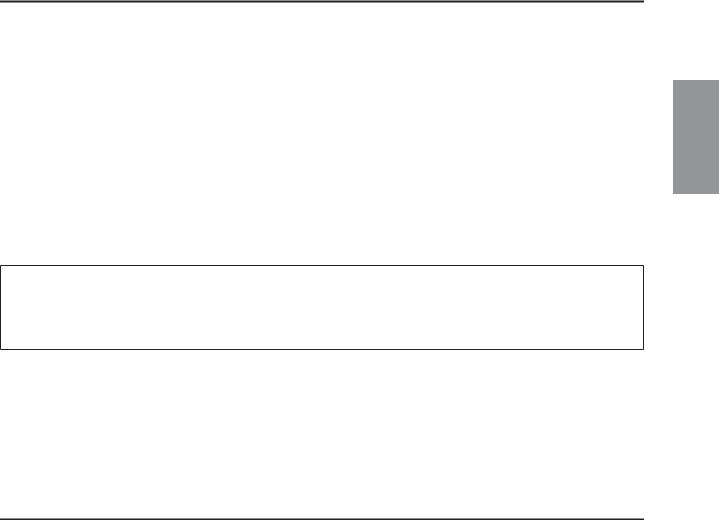
Thank you for purchasing the Yamaha Clavinova! We recommend that you read this manual carefully so that you can fully take advantage of the advanced and convenient functions of the Clavinova.
We also recommend that you keep this manual in a safe and handy place for future reference.
About this Owner’s Manual
This manual consists of three main sections: “Introduction,” “Reference” and “Appendix.”
 Introduction (page 2):
Introduction (page 2):
Please read this section first.
 Reference (page 13):
Reference (page 13):
This section explains how to make detailed settings for the Clavinova’s various functions.
 Appendix (page 77):
Appendix (page 77):
This section introduces reference material.
*The models CLP-240/230 will be referred to as the CLP/Clavinova in this owner’s manual.
*The illustrations and LED displays shown in this owner’s manual are for instructional purposes only and may appear somewhat different from those on your instrument.
*The panel illustrations shown in this owner’s manual are taken from the CLP-240.
*Copying of commercially available software or music data for purposes other than your personal use is strictly prohibited.
COPYRIGHT NOTICE
This product incorporates and bundles computer programs and contents in which Yamaha owns copyrights or with respect to which it has license to use others’ copyrights. Such copyrighted materials include, without limitation, all computer software and MIDI files, etc. Any unauthorized use of such programs and contents outside of personal use is not permitted under relevant laws. Any violation of copyright has legal consequences. DON’T MAKE, DISTRIBUTE OR USE ILLEGAL COPIES.
Trademarks:
•Apple and Macintosh are trademarks of Apple Computer, Inc.
•Windows is a registered trademark of Microsoft® Corporation.
•SmartMedia is a trademark of Toshiba Corporation.
•All other trademarks are the property of their respective holders.
Accessories
•“50 Greats for the Piano” (Music Book)
•Owner’s Manual
This manual contains complete instructions for operating your Clavinova.
•Accessory CD-ROM for Windows
•Accessory CD-ROM for Windows Installation Guide
•Bench
A bench may be included or optional, depending on your locale.
 Tuning
Tuning
Unlike an acoustic piano, the Clavinova does not need to be tuned. It always stays perfectly in tune.
 Transporting
Transporting
If you move to another location, you can transport the Clavinova along with your other belongings. You can move the unit as it is (assembled) or you can disassemble the unit.
Transport the keyboard horizontally. Do not lean it up against a wall or stand it up on its side. Do not subject the instrument to excessive vibration or shock.
ENGLISH
CLP-240/230 Owner’s Manual |
3 |
|
|

ENGLISH
Table of Contents
Introduction |
|
About this Owner’s Manual ............................... |
3 |
Accessories ......................................................... |
3 |
Application Index ............................................... |
5 |
Panel Controls and Terminals............................ |
8 |
Before Using the Clavinova ............................. |
10 |
Key Cover.................................................................... |
10 |
Music Rest................................................................... |
10 |
Music Braces (CLP-240) ............................................ |
10 |
Turning the Power On ............................................... |
11 |
Setting the Volume ..................................................... |
12 |
Using Headphones ..................................................... |
12 |
Using the Speaker Switch ........................................... |
12 |
Reference |
|
Listening to the Demonstration Tunes............ |
14 |
Listening to 50 Piano Preset Songs ................. |
15 |
Practicing a One-Hand Part Using 50 Preset Songs |
|
(Part Cancel Function)............................................... |
17 |
A-B Repeat for 50 Preset Songs ................................. |
18 |
Selecting & Playing Voices............................... |
19 |
Selecting Voices .......................................................... |
19 |
Using the Pedals.......................................................... |
20 |
Adding Variations to the Sound – [VARIATION] |
|
(CLP-240)/[BRILLIANCE]/[REVERB]/[EFFECT]/ |
|
[DDE] (CLP-240)....................................................... |
21 |
Touch Sensitivity – [TOUCH] .................................. |
23 |
Transposition – [TRANSPOSE] ................................ |
24 |
Combining Two Voices (Dual mode)....................... |
25 |
Splitting the Keyboard Range and Playing |
|
Two Different Voices (Split mode) (CLP-240)......... |
26 |
Using the Metronome ................................................ |
28 |
Recording Your Performance .......................... |
29 |
Recording a performance quickly.............................. |
29 |
Re-recording a previously recorded song.................. |
31 |
Recording to RIGHT/LEFT ....................................... |
32 |
Changing the Initial Settings |
|
(Data recorded at the beginning of a song) .............. |
34 |
Handling Songs with a USB Storage Device |
|
(CLP-240).......................................................... |
35 |
About Save and Export............................................... |
35 |
Saving Songs ............................................................... |
36 |
Exporting a Song in SMF format............................... |
37 |
Deleting Song Files ..................................................... |
38 |
Formatting the USB Storage Device .......................... |
39 |
Playing Back Songs .......................................... |
40 |
Playing Back User/External Songs on the Instrument |
|
..................................................................................... |
41 |
Playing Back User Files from a USB Storage Device |
|
(CLP-240) ................................................................... |
42 |
Playing Back SMF/External songs from a USB storage |
|
device (CLP-240)........................................................ |
43 |
Useful Playback Functions......................................... |
43 |
Detailed Settings – [FUNCTION]...................... |
44 |
Basic Procedure in Function Mode........................... |
45 |
About Each Function ................................................. |
47 |
F1. Fine Tuning of the Pitch............................... |
47 |
F2. Selecting a Scale............................................. |
48 |
F3. Dual Mode Functions ................................... |
49 |
F4. (CLP-240) Split Mode Functions ................. |
50 |
F5. (CLP-240) / F4. (CLP-230) |
|
Other Functions ........................................... |
51 |
F6. (CLP-240) / F5. (CLP-230) |
|
Metronome Volume .................................... |
52 |
F7. (CLP-240) / F6. (CLP-230) |
|
Song Part Cancel Volume............................ |
52 |
F8. (CLP-240) / F7. (CLP-230) |
|
MIDI Functions ........................................... |
52 |
F9. (CLP-240) / F8. (CLP-230) |
|
Backup Functions......................................... |
55 |
F9.5 (CLP-240)/ F8.5 (CLP-230) |
|
Character Code ............................................ |
55 |
Connections ..................................................... |
56 |
Connectors ................................................................. |
56 |
Connection to a USB storage device (CLP-240) ...... |
58 |
Connecting a Personal Computer............................. |
60 |
Data Backup ..................................................... |
62 |
Message List ..................................................... |
63 |
Troubleshooting............................................... |
64 |
Options............................................................. |
64 |
CLP-240/230: Keyboard Stand Assembly ........ |
65 |
Handling the Floppy Disk Drive (FDD) |
|
and Floppy Disks (CLP-240) ............................. |
69 |
Installing the Floppy Disk Drive (Optional)..... |
70 |
Preset Voice List ............................................... |
71 |
Demo Song List ................................................ |
74 |
Index................................................................. |
75 |
Appendix |
|
Factory Setting List .......................................... |
78 |
MIDI Data Format ............................................ |
80 |
MIDI Implementation Chart ............................ |
84 |
Specifications ................................................... |
85 |
4 |
CLP-240/230 Owner’s Manual |
|
|
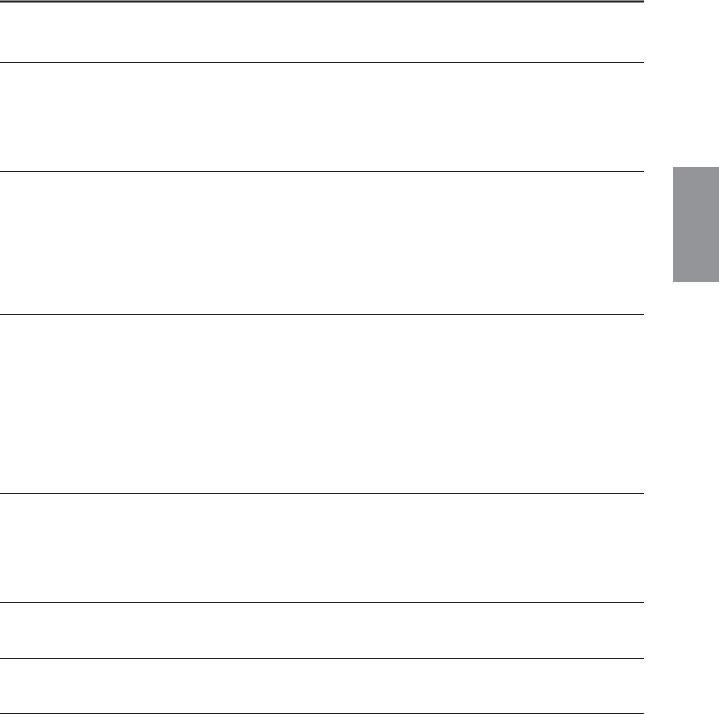
Application Index
Use this index to find reference pages that may be helpful for your particular application and situation.
Listening
Listening to demo songs with different voices.................................................. |
“Listening to the Demonstration Tunes” on page 14 |
Listening to songs from “50 Greats for the Piano”................................................. |
“Listening to 50 Piano Preset Songs” on page 15 |
Listening to my recorded performance............................................................................................ |
“Playing Back Songs” on page 40 |
Listening to songs in the USB storage device ........................................................................ |
..........“Playing Back Songs” on page 40 |
Playing
Using the three performance control pedals ........................................................................................ |
“Using the Pedals” on page 20 |
Simulating the natural sustain created by the damper pedal on a real grand piano ....................... |
“[DDE]” (CLP-240) on page 22 |
Playing an accompaniment that matches pitch........................................................... |
“Transposition – [TRANSPOSE]” on page 24 |
Selecting a touch sensitivity type.................................................................................... |
“Touch Sensitivity – [TOUCH]” on page 23 |
Fine tuning the pitch of the entire instrument when you play the Clavinova along with other instruments or CD music |
|
..................................................................................................................................................... |
“Fine tuning of the pitch” on page 47 |
Changing voices
Viewing the list of voices |
........................................................................................................................“Preset Voice List” on page 71 |
Combining two voices ......................................................................................... |
“Combining Two Voices (Dual mode)” on page 25 |
Playing different sounds with left and right hands
........................................... “Splitting the Keyboard Range and Playing Two Different Voices (Split mode) (CLP-240)” on page 26
Making the sound more brilliant or mellower |
...................................................................................... “[BRILLIANCE]” on page 21 |
Simulating a concert hall ................................................................................................................................ |
“[REVERB]” on page 21 |
Adding spread or swell to the sound............................................................................................................... |
“[EFFECT]” on page 22 |
Enhancing the sound with effects ......................................................................................... |
“[VARIATION]” (CLP-240) on page 21 |
Practicing
Muting the rightor left-hand part....... |
“Practicing a One-Hand Part Using 50 Preset Songs (Part Cancel Function)” on page 17 |
|
Practicing a specified phrase repeatedly |
........................................................................ |
“A-B Repeat for 50 Preset Songs” on page 18 |
Practicing with an accurate and steady tempo ............................................................................ |
“Using the Metronome” on page 28 |
|
Practicing using your recorded song................................................................................ |
|
“Recording Your Performance” on page 29 |
Recording
Recording your performance............................................................................................ “Recording Your Performance” on page 29
Settings
Adjusting the Clavinova settings .............................................................................. “Detailed Settings – [FUNCTION]” on page 44
Connecting the Clavinova to other devices
What is MIDI? ............................................................................................................................................... |
“About MIDI” on page 57 |
Making detailed settings for MIDI ....................................................................................................... |
“MIDI Functions” on page 52 |
Recording your performance......................................................................... |
“AUX OUT [L] [R] (LEVEL FIXED) jacks” on page 56 |
Raising the volume......................................................................................... |
“AUX OUT [L] [R] (LEVEL FIXED) jacks” on page 56 |
Outputting other instruments’ sound from the Clavinova ................................................. |
“AUX IN [L/L+R] [R] jacks” on page 57 |
Connecting to a USB storage device .................................................. |
“Connection to a USB storage device (CLP-240)” on page 58 |
Connecting a computer ............................................................................................. |
“Connecting a Personal Computer” on page 60 |
Assembling |
|
|
|
Assembling and disassembling the Clavinova .............................................. “CLP-240/230: Keyboard Stand Assembly” on page 65
ENGLISH
CLP-240/230 Owner’s Manual |
5 |
|
|
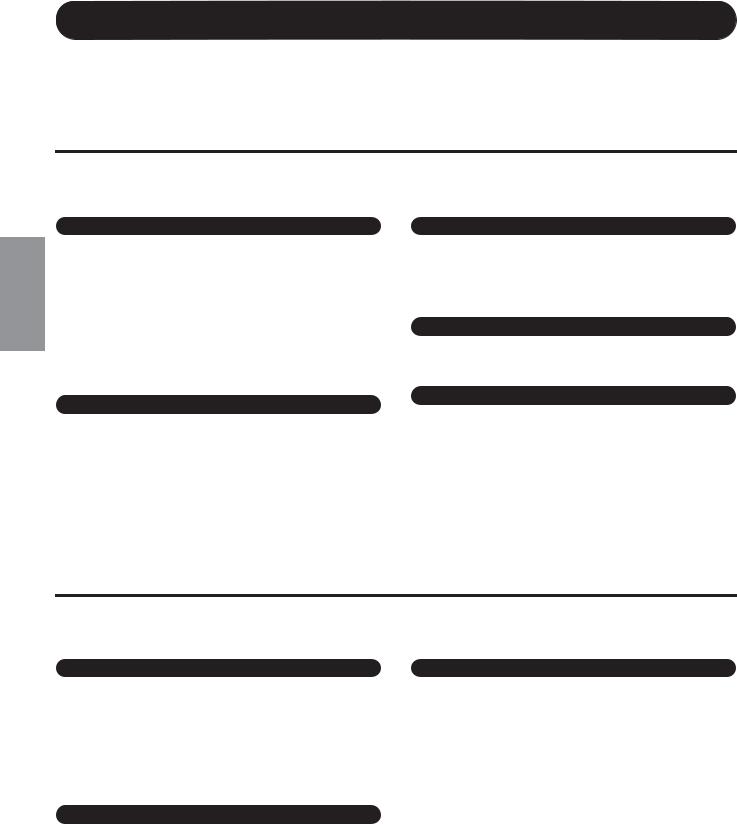
ENGLISH
PRECAUTIONS
PLEASE READ CAREFULLY BEFORE PROCEEDING
* Please keep this manual in a safe place for future reference.
 WARNING
WARNING
Always follow the basic precautions listed below to avoid the possibility of serious injury or even death from electrical shock, short-circuiting, damages, fire or other hazards. These precautions include, but are not limited to, the following:
Power supply/Power cord
•Only use the voltage specified as correct for the instrument. The required voltage is printed on the name plate of the instrument.
•Check the electric plug periodically and remove any dirt or dust which may have accumulated on it.
•Use only the supplied power cord/plug.
•Do not place the power cord near heat sources such as heaters or radiators, and do not excessively bend or otherwise damage the cord, place heavy objects on it, or place it in a position where anyone could walk on, trip over, or roll anything over it.
Water warning
•Do not expose the instrument to rain, use it near water or in damp or wet conditions, or place containers on it containing liquids which might spill into any openings.
•Never insert or remove an electric plug with wet hands.
Fire warning
•Do not put burning items, such as candles, on the unit. A burning item may fall over and cause a fire.
|
|
|
|
If you notice any abnormality |
|
|
|
Do not open |
|
• If the power cord or plug becomes frayed or damaged, or if there is a sudden |
|||
• Do not open the instrument or attempt to disassemble the internal parts or |
||||||
|
loss of sound during use of the instrument, or if any unusual smells or smoke |
|||||
|
modify them in any way. The instrument contains no user-serviceable parts. If it |
|
||||
|
|
should appear to be caused by it, immediately turn off the power switch, |
||||
|
should appear to be malfunctioning, discontinue use immediately and have it |
|
||||
|
|
disconnect the electric plug from the outlet, and have the instrument inspected |
||||
|
inspected by qualified Yamaha service personnel. |
|
||||
|
|
by qualified Yamaha service personnel. |
||||
|
|
|
|
|||
 CAUTION
CAUTION
Always follow the basic precautions listed below to avoid the possibility of physical injury to you or others, or damage to the instrument or other property. These precautions include, but are not limited to, the following:
|
|
|
Power supply/Power cord |
Location |
•When removing the electric plug from the instrument or an outlet, always hold the plug itself and not the cord. Pulling by the cord can damage it.
•Remove the electric plug from the outlet when the instrument is not to be used for extended periods of time, or during electrical storms.
•Do not connect the instrument to an electrical outlet using a multiple-connector. Doing so can result in lower sound quality, or possibly cause overheating in the outlet.
Assembly
•Read carefully the attached documentation explaining the assembly process. Failure to assemble the instrument in the proper sequence might result in damage to the instrument or even injury.
•Do not expose the instrument to excessive dust or vibrations, or extreme cold or heat (such as in direct sunlight, near a heater, or in a car during the day) to prevent the possibility of panel disfiguration or damage to the internal components.
•Do not use the instrument in the vicinity of a TV, radio, stereo equipment, mobile phone, or other electric devices. Otherwise, the instrument, TV, or radio may generate noise.
•Do not place the instrument in an unstable position where it might accidentally fall over.
•Before moving the instrument, remove all connected cables.
•When setting up the product, make sure that the AC outlet you are using is easily accessible. If some trouble or malfunction occurs, immediately turn off the power switch and disconnect the plug from the outlet. Even when the power switch is turned off, electricity is still flowing to the product at the minimum level. When you are not using the product for a long time, make sure to unplug the power cord from the wall AC outlet.
(1)B-11 1/2
6 |
CLP-240/230 Owner’s Manual |
|
|
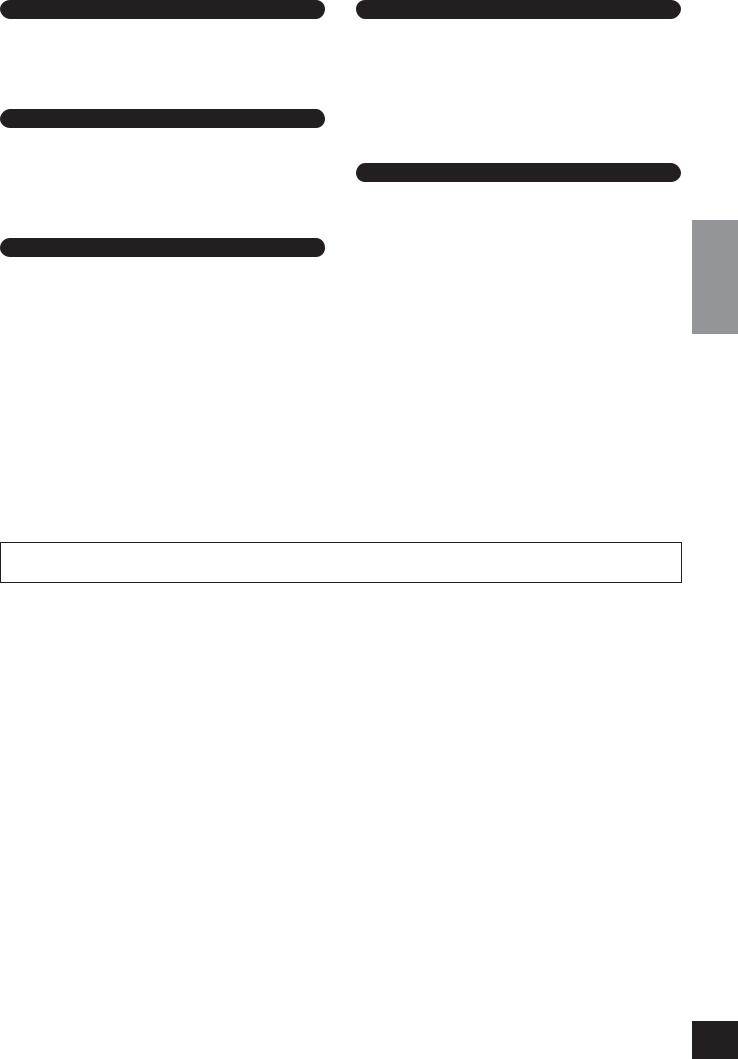
Connections
•Before connecting the instrument to other electronic components, turn off the power for all components. Before turning the power on or off for all components, set all volume levels to minimum. Also, be sure to set the volumes of all components at their minimum levels and gradually raise the volume controls while playing the instrument to set the desired listening level.
Maintenance
•In the case of a model with a polished finish, gently remove dust and dirt with a soft cloth. Do not wipe too hard since small particles of dirt can scratch the instrument's finish.
•When cleaning the instrument, use a soft, dry or slightly damp cloth. Do not use paint thinners, solvents, cleaning fluids, or chemical-impregnated wiping cloths.
Handling caution
•Take care that the key cover does not pinch your fingers, and do not insert a finger or hand in any gaps on the key cover or instrument.
•Never insert or drop paper, metallic, or other objects into the gaps on the key cover, panel or keyboard. If this happens, turn off the power immediately and unplug the power cord from the AC outlet. Then have the instrument inspected by qualified Yamaha service personnel.
•Do not place vinyl, plastic or rubber objects on the instrument, since this might discolor the panel or keyboard.
•In the case of a model with a polished finish, bumping the surface of the instrument with metal, porcelain, or other hard objects can cause the finish to crack or peel. Use caution.
•Do not rest your weight on, or place heavy objects on the instrument, and do not use excessive force on the buttons, switches or connectors.
•Do not use the instrument/device or headphones for a long period of time at a high or uncomfortable volume level, since this can cause permanent hearing loss. If you experience any hearing loss or ringing in the ears, consult a physician.
Using the bench (If included)
•Do not place the bench in an unstable position where it might accidentally fall over.
•Do not play carelessly with or stand on the bench. Using it as a tool or stepladder or for any other purpose might result in accident or injury.
•Only one person should sit on the bench at a time, in order to prevent the possibility of accident or injury.
•If the bench screws become loose due to extensive long-term use, tighten them periodically using the included tool.
Saving data
Saving and backing up your data
•The panel settings and certain other types of data will be lost if the power is turned off before they have been saved. Be sure to save (back up) data you want to keep to the internal Flash Memory before turning off the power (page 55). Keep in mind that this data is for temporary backup purposes and may be inadvertently lost due to malfunction or incorrect operation. Make sure to save all your important data to computer for permanent safekeeping (page 62).
Yamaha cannot be held responsible for damage caused by improper use or modifications to the instrument, or data that is lost or destroyed.
Always turn the power off when the instrument is not in use.
(1)B-11 2/2
CLP-240/230 Owner’s Manual
ENGLISH
7

Panel Controls and Terminals
ENGLISH
Panel Controls and Terminals
The Yamaha Clavinova CLP-240/230 digital piano provides natural, expressive grand piano sound and playability, and features Yamaha’s original “AWM Dynamic Stereo Sampling (CLP-240)/AWM Stereo Sampling (CLP-230)” tone-genera- tion technology for rich, musical voices.
The CLP-240/230 Grand Piano 1 and 2 voices feature samples painstakingly recorded from a full concert grand piano. The CLP-240 Grand Piano 1 voice features three velocity-switched samples (Dynamic Sampling), special “Sustain Sampling” (page 51) that samples the unique resonance of an acoustic grand piano’s soundboard and strings when the damper pedal is pressed, and “Keyoff Samples” that add the subtle sound produced when the keys are released.
The CLP-240/230 also utilizes a “GH3 (Graded Hammer 3)” Keyboard that varies the key weight according to the key range. Moreover, this specially crafted keyboard lets you use techniques only possible on grand pianos, such as playing the same note successively and having the sounds blend smoothly even without use of the damper pedal, or playing the same key quickly and having perfect articulation without the sound cutting off unnaturally. With these features, the CLP-240/ 230 comes much closer to the sound of a true acoustic piano.
(The panel illustration is taken from the CLP-240) |
|
|
|
|
|
|
|
|
|
|
|
|
|
|
|||
|
2 |
3 |
4 |
|
6 |
|
|
|
|
|
|
! |
|
|
|
|
|
|
|
|
|
LEFT |
RIGHT |
|
|
|
|
ON/OFF |
|
TEMPO/OTHER VALUE |
|
|
|
||
|
|
|
|
|
|
|
USB |
SAVE/EXP. |
|
|
|
|
|
|
|
|
|
|
|
|
REC |
STOP |
PLAY/PAUSE |
USER |
LOAD |
TEMPO |
METRONOME |
|
|
|
|
|
|||
MIN |
MAX |
|
ON |
|
|
|
PRESET |
FORMAT/DEL. |
FUNCTION# |
|
|
|
|
|
|
|
|
|
MASTER VOLUME |
|
|
SYNC START |
SONG SELECT |
FILE |
|
TEMPO / FUNCTION# |
|
|
|
|
|
||||
|
DEMO |
TRANSPOSE |
SONG |
|
|
|
|
|
|
||||||||
|
|
|
5 |
|
7 |
|
8 |
9 |
|
) |
|
@ |
|
|
* |
||
|
|
|
|
|
|
|
|
|
|
|
|
|
|
|
|
|
|
|
|
|
|
GRAND |
GRAND |
E.PIANO |
E.PIANO |
HARPSI- |
E.CLAVI- |
VIBRA- |
VARIATION |
|
|
|
|
|
|
|
|
|
|
PIANO1 |
PIANO 2 |
1 |
2 |
CHORD |
CHORD |
PHONE |
|
|
|
|
|
||
|
|
|
|
|
|
|
|
|
|
|
|
|
|
ROOM |
CHORUS |
|
|
|
|
|
|
|
|
|
|
|
|
|
|
|
BRIGHT |
HALL 1 |
PHASER |
HARD |
|
|
|
|
–/ NO +/ YES |
CHURCH |
JAZZ |
STRINGS |
|
GUITAR |
WOOD |
E.BASS |
|
NORMAL |
HALL 2 |
TREMOLO |
MEDIUM |
ON |
|
|
|
|
ORGAN |
ORGAN |
CHOIR |
BASS |
SPLIT |
MELLOW |
STAGE |
ROTARYSP |
SOFT |
||||||
|
|
|
|
|
|
|
|
VOICE |
|
|
|
BRILLIANCE |
REVERB |
EFFECT |
TOUCH |
DDE |
|
|
|
|
|
|
|
|
|
|
|
|
|
|
|
|
|
|
CLP-240 |
|
|
|
# |
|
|
|
|
$ |
|
|
|
% |
|
^ |
|
& |
|
(
1
SELECT
USB TO DEVICE
OFF |
|
|
|
|
|
ON |
|
|
|
|
|
NORMAL |
|
|
|
|
|
HP. SW |
|
|
|
|
|
SPEAKER |
|
|
|
|
|
¢ |
|
|
|
∞ |
|
|
|
|
|
|
|
PHONES |
|
|
|
|
|
º |
|
¡ |
|
CLP-240 |
|
(LEVEL FIXED) |
|
|
|
|
|
R L |
R |
L/L+R |
|
|
|
AUX OUT |
|
AUX IN |
|
|
|
|
USB |
|
|
|
|
TO DEVICE |
TO HOST |
IN |
OUT |
THRU |
|
|
MIDI |
|
|
||
( |
™ |
£ |
|
CLP-230 |
|
|
|
|
|
|
|
|
(LEVEL FIXED) |
|
MIDI |
TO HOST |
|
|
|
THRU OUT |
IN |
||
|
R |
L |
R |
L/L+R |
USB |
|
AUX OUT |
AUX IN |
|
|
|
|
|
º |
¡ |
£ |
™ |
8 |
CLP-240/230 Owner’s Manual |
|
|

1 |
[POWER] switch ........................... |
page 11 |
2 |
[MASTER VOLUME] slider ........... |
page 12 |
|
Adjust the volume level using this slider. |
|
3 |
[DEMO] button............................ |
page 14 |
|
Demonstration playback is available for each voice. |
|
4 |
[TRANSPOSE] button................... |
page 24 |
|
You can shift the pitch of the entire keyboard up or |
|
|
down so that the pitch will match that of another |
|
|
instrument or singer, while you play the same, |
|
|
unshifted keys. |
|
5 |
[REC] button ................................ |
page 29 |
|
For recording your keyboard performance. |
|
6 |
[RIGHT], [LEFT] buttons ....... |
pages 17, 32 |
|
For turning the leftand right-hand parts on or off as |
|
|
required so you can practice the corresponding part |
|
|
(the part that is turned off) on the keyboard. |
|
7 |
[PLAY/PAUSE], [STOP] buttons |
|
|
.............................................. |
pages 15, 41 |
|
For playing back the preset songs, your recorded |
|
|
material or commercially available music data, etc. |
|
8 |
[SONG SELECT] button ........ |
pages 15, 41 |
|
For selecting a song to play back or edit. |
|
9 |
[FILE] button (CLP-240)........ |
pages 35, 42 |
|
For saving recorded songs and managing song files. |
|
|
Also lets you format a USB storage device. |
|
) [TEMPO/FUNCTION#] button |
||
|
.............................................. |
pages 28, 45 |
|
For changing the song tempo (speed) and selecting |
|
|
other useful functions (pages 44-55). |
|
! [METRONOME] button......... |
pages 28, 52 |
|
|
For using the metronome. |
|
@ Display ......................................... |
page 11 |
|
 CAUTION
CAUTION
Do not turn off the power to the instrument while flashing dashes appear in the display (indicating the operation is in process). Doing so may damage the data.
#[–/NO], [+/YES] buttons
For setting values or performing file operations. Pressing both buttons simultaneously for certain value settings (Transpose, Tempo, etc.) restores the default value.
$ Voice group buttons.................... |
page 19 |
For selecting voices from 14 internal sounds including Grand Piano 1 and 2. You can also combine two voices and use them together. (Only the CLP-240 has the [VARIATION] button.)
Panel Controls and Terminals
% [SPLIT] button (CLP-240)............. |
page 26 |
For playing different voices on the leftand right- |
|
hand sections of the keyboard. |
|
^ [BRILLIANCE], [REVERB], [EFFECT] |
|
buttons......................................... |
page 21 |
For adjusting the brightness of the sound and adding reverb and chorus effects to the sound.
& [TOUCH] button .......................... |
page 23 |
For fine-tuning the touch response.
* [DDE] button (CLP-240) .............. |
page 22 |
|
For turning the DDE (Dynamic Damper Effect) |
|
|
function on or off. When DDE is on, the Clavinova |
ENGLISH |
|
|
|
|
simulates the sustain sound that occur when you press the damper pedal of a grand piano, as you press the damper pedal and play the keyboard.
( USB [TO DEVICE] terminals (CLP-240)
.....................................................page 57
For connecting the instrument to a USB storage device, allowing saving/loading of data to and from the connected device. The instrument has two TO DEVICE terminals, A and B, which can be specified using the [SELECT] switch.
º AUX OUT [L] [R] (LEVEL FIXED) jacks
.....................................................page 56
For outputting the sound of the Clavinova to an external audio system, or connecting it to another device (cassette tape recorder, etc.) to record your performance.
¡ AUX IN [L/L+R] [R] jacks .............. |
page 57 |
For connecting an external tone generator, allowing you to play the sound of that device via the Clavinova’s internal sound system and speakers.
™ USB [TO HOST] terminal ............. |
page 57 |
For connecting the instrument to your computer, allowing you to transfer MIDI data between the Clavinova and the computer.
£ MIDI [IN] [OUT] [THRU] terminals
.....................................................page 57
For connecting external MIDI devices, allowing the use of various MIDI functions.
¢ [PHONES] jacks, [SPEAKER] switch
.....................................................page 12
For connecting a set of standard stereo headphones, allowing private practice. The [SPEAKER] switch turns the internal speakers on or off.
∞ PEDALS......................................... |
page 20 |
For producing a range of expressive effects similar to those produced by the pedals on an acoustic piano. The left pedal can also be assigned to a variety of functions.
CLP-240/230 Owner’s Manual |
9 |
|
|
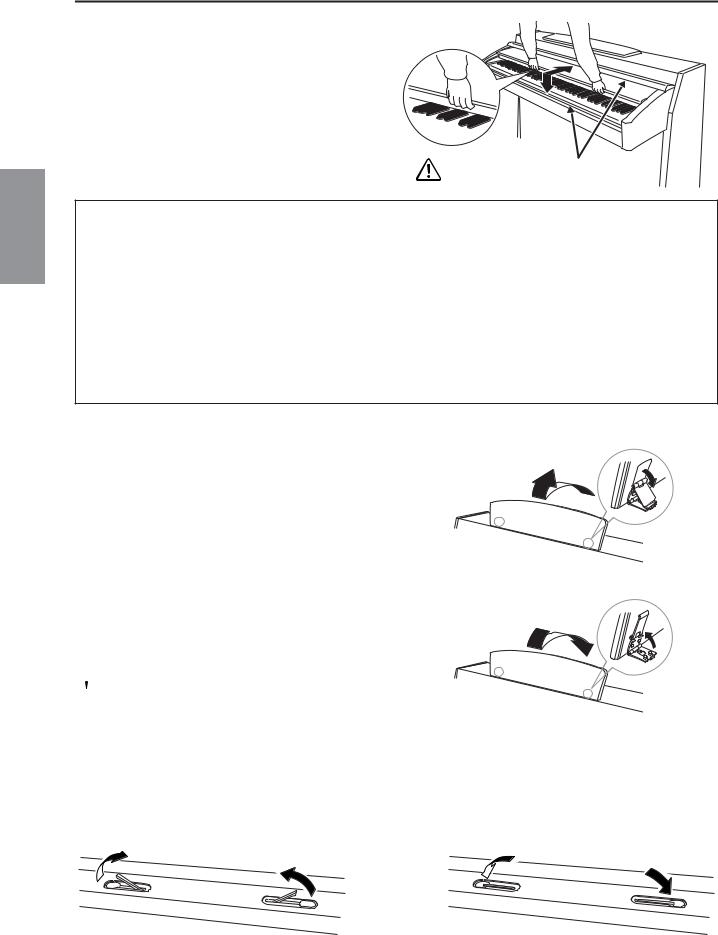
Before Using the Clavinova
Before Using the Clavinova
ENGLISH
 Key Cover
Key Cover
To open the key cover:
Lift the cover slightly, then push and slide it open.
To close the key cover:
Slide the cover toward you and gently lower the cover over the keys.
Be careful to avoid catching your fingers when opening or closing the cover.
 CAUTION
CAUTION
Hold the cover with both hands when opening or closing it. Do not release it until it is fully opened or closed. Be careful to avoid catching fingers (yours or others, especially children’s) between the cover and main unit.
 CAUTION
CAUTION
Do not place objects such as a piece of metal or paper on top of the key cover. Small objects placed on the key cover may fall inside the unit when the cover is opened and may be nearly impossible to remove. This could cause electric shock, short circuit, fire or other serious damage to the instrument.
 CAUTION
CAUTION
Disconnect the optional USB storage device connected to the [USB TO DEVICE] A terminal before closing the key cover. Closing the cover with the device still connected may damage the device.
 Music Rest
Music Rest
To raise the music rest:
1. Pull the music rest up and toward yourself as far as it will go.
2.Flip down the two metal supports at the left and right on the rear of the music rest.
3.Lower the music rest so that it rests on the metal supports.
To lower the music rest:
1.Pull the music rest toward yourself as far as it will go.
2.Raise the two metal supports (at the rear of the music rest).
3. Gently lower the music rest backward until it is all the way down.
 CAUTION
CAUTION
Do not try to use the music rest in a half-raised position. When lowering the music rest, do not release your hands from the music rest until it is all the way down.
 Music Braces (CLP-240)
Music Braces (CLP-240)
These braces are for holding the pages of music books in place.
To open |
To close |
10 |
CLP-240/230 Owner’s Manual |
|
|
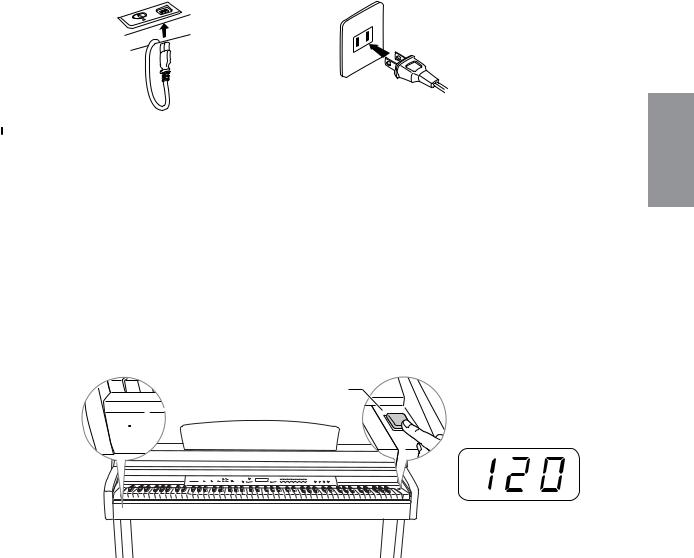
Before Using the Clavinova
 Turning the Power On
Turning the Power On
1.Connect the power cord.
Insert the plugs at the ends of the cord, one into the AC INLET on the Clavinova, and the other into a standard AC outlet.
In some areas, a plug adaptor may be provided to match the pin configuration of the AC wall outlets in your area.
1-1 |
1-2 |
(The shape of plug differs depending on locale.)
(bottom surface)
 CAUTION
CAUTION
Make sure your CLP-240/230 is rated for the AC voltage supplied in the area in which it is to be used (voltage rating appears on the name plate on the bottom panel). In some areas, a voltage selector may be provided on the bottom panel of the main keyboard unit near the power cord. Make sure that the voltage selector is set for the voltage in your area. Connecting the unit to the wrong AC supply can cause serious damage to the internal circuitry and may even pose a shock hazard!
Use only the AC power cord supplied with the CLP-240/230. If the supplied cord is lost or damaged and needs to be replaced, contact your Yamaha dealer. The use of an inappropriate replacement can pose a fire and shock hazard!
The type of AC power cord provided with the CLP-240/230 may be different depending on the country in which it is purchased. (In some areas a plug adaptor may be provided to match the pin configuration of the AC wall outlets in your area.) Do NOT modify the plug provided with the CLP-240/230. If the plug will not fit the outlet, have a proper outlet installed by a qualified electrician.
ENGLISH
2.Turn the power on.
Press the [POWER] switch.
• The display located in the center of the front panel and the power indicator located below the left end of the keyboard lights up.
[POWER] switch
 Power indicator
Power indicator
Display
Normally indicates tempo.
When you’re ready to turn off the power, press the [POWER] switch again.
• The display and the power indicator turn off.
NOTE |
Power indicator |
|
If you close the key cover without turning the power off, the power indicator remains lit, indicating that the power is |
|
still on. |
CLP-240/230 Owner’s Manual |
11 |
|
|
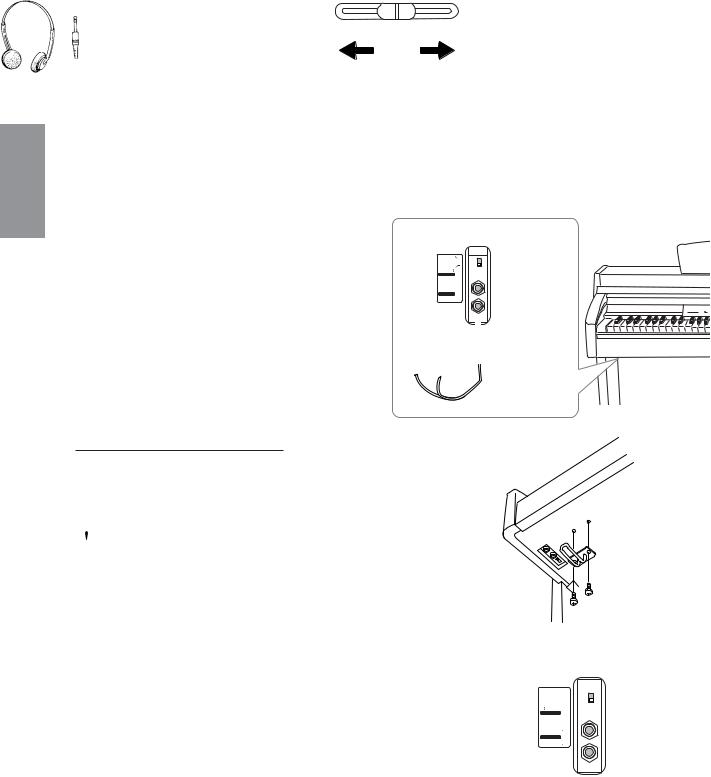
Before Using the Clavinova
ENGLISH
 Setting the Volume
Setting the Volume
Initially set the [MASTER VOLUME] slider about halfway between the “MIN” and “MAX” settings. Then, when you start playing, re-adjust the [MASTER VOLUME] slider to the most comfortable listening level.
MIN









 MAX
MAX
 MASTER VOLUME
MASTER VOLUME
The level decreases. |
The level increases. |
 CAUTION
CAUTION
Do not use the Clavinova at a high volume level for a long period of time, or your hearing may be damaged.
TERMINOLOGY |
MASTER VOLUME: |
|
The volume level of the entire keyboard sound |
|
You can also adjust the [PHONES] output level and the AUX IN input level using the [MASTER VOLUME] slider. |
NOTE |
 Using Headphones
Using Headphones
Connect a pair of headphones to one of the [PHONES] jacks.
Two [PHONES] jacks are provided.
You can connect two sets of standard stereo headphones. (If you are using only one pair of headphones, you can plug them into either jack.)
Using the Headphone Hanger
A headphone hanger is included in the CLP-240/230 package so that you can hang the headphones on the Clavinova. Install the headphone hanger using included two screws (4 × 10mm) as shown in the figure.
 CAUTION
CAUTION
Do not hang anything other than the headphones on the hanger. Otherwise, the Clavinova or the hanger may be damaged.
bottom surface
OFF
ON
NORMAL
HP. SW
SPEAKER
PHONES |
standard |
|
stereo |
|
phone plug |
 Using the Speaker Switch
Using the Speaker Switch
This switch turns the internal speakers on or off.
NORMAL (HP. SW) ......... |
The speakers produce sound as long as a pair of |
|
headphones is not connected. |
ON ....................................... |
The speakers always produce sound. |
OFF ...................................... |
The speakers produce no sound. |
OFF
ON
NORMAL HP. SW
HP. SW
SPEAKER
PHONES
12 |
CLP-240/230 Owner’s Manual |
|
|

Reference |
This section explains how to make detailed settings for the |
|
|
|
Clavinova’s various functions. |
Listening to the Demonstration Tunes ............................ |
14 |
Listening to 50 Piano Preset Songs................................... |
15 |
Practicing a One-Hand Part Using 50 Preset Songs (Part |
|
Cancel Function)................................................................... |
17 |
A-B Repeat for 50 Preset Songs ............................................ |
18 |
Selecting & Playing Voices ................................................ |
19 |
Selecting Voices ..................................................................... |
19 |
Using the Pedals .................................................................... |
20 |
Adding Variations to the Sound – [VARIATION] (CLP-240)/ [BRILLIANCE]/[REVERB]/[EFFECT]/[DDE] (CLP-240) 21
Touch Sensitivity – [TOUCH].............................................. |
23 |
Transposition – [TRANSPOSE] ........................................... |
24 |
Combining Two Voices (Dual mode)................................... |
25 |
Splitting the Keyboard Range and Playing Two Different |
|
Voices (Split mode) (CLP-240) ............................................ |
26 |
Using the Metronome ........................................................... |
28 |
Recording Your Performance ........................................... |
29 |
Recording a performance quickly ........................................ |
29 |
Re-recording a previously recorded song ............................ |
31 |
Recording to RIGHT/LEFT .................................................. |
32 |
Changing the Initial Settings (Data recorded at the beginning |
|
of a song) ............................................................................... |
34 |
Handling Songs with a USB Storage Device (CLP-240) . 35
About Save and Export ......................................................... |
35 |
Saving Songs.......................................................................... |
36 |
Exporting a Song in SMF format ......................................... |
37 |
Deleting Song Files................................................................ |
38 |
Formatting the USB Storage Device .................................... |
39 |
Playing Back Songs ........................................................... |
40 |
Playing Back User/External Songs on the Instrument ........ |
41 |
Playing Back User Files from a USB Storage Device (CLP- |
|
240) ........................................................................................ |
42 |
Playing Back SMF/External songs from a USB storage device |
|
(CLP-240) .............................................................................. |
43 |
Useful Playback Functions.................................................... |
43 |
Detailed Settings – [FUNCTION] ................................... |
44 |
Basic Procedure in Function Mode...................................... |
45 |
About Each Function ............................................................ |
47 |
F1. Fine Tuning of the Pitch ................................................. |
47 |
F2. Selecting a Scale ............................................................... |
48 |
|
F3. Dual Mode Functions...................................................... |
49 |
|
F4. |
(CLP-240) Split Mode Functions.................................... |
50 |
F5. |
(CLP-240)/F4. (CLP-230) Other Functions ................... |
51 |
F6. |
(CLP-240)/F5. (CLP-230) Metronome Volume ............. |
52 |
F7. |
(CLP-240)/F6. (CLP-230) Song Part Cancel Volume .... |
52 |
F8. |
(CLP-240)/F7. (CLP-230) MIDI Functions ................... |
52 |
F9. |
(CLP-240)/F8. (CLP-230) Backup Functions ................ |
55 |
F9.5 (CLP-240)/F8.5 (CLP-230) Character Code ................ |
55 |
|
Connections ...................................................................... |
56 |
|
Connectors............................................................................. |
56 |
|
Connecting a Personal Computer......................................... |
60 |
|
Data Backup ...................................................................... |
62 |
|
Message List....................................................................... |
63 |
|
Troubleshooting ................................................................ |
64 |
|
Options .............................................................................. |
64 |
|
CLP-240/230: Keyboard Stand Assembly......................... |
65 |
|
Handling the Floppy Disk Drive (FDD) and Floppy Disks |
||
(CLP-240) .......................................................................... |
69 |
|
Installing the Floppy Disk Drive (Optional) ................... |
70 |
|
Preset Voice List................................................................. |
71 |
|
Demo Song List................................................................. |
74 |
|
Index .................................................................................. |
|
75 |
ENGLISH
CLP-240/230 Owner’s Manual |
13 |
|
|
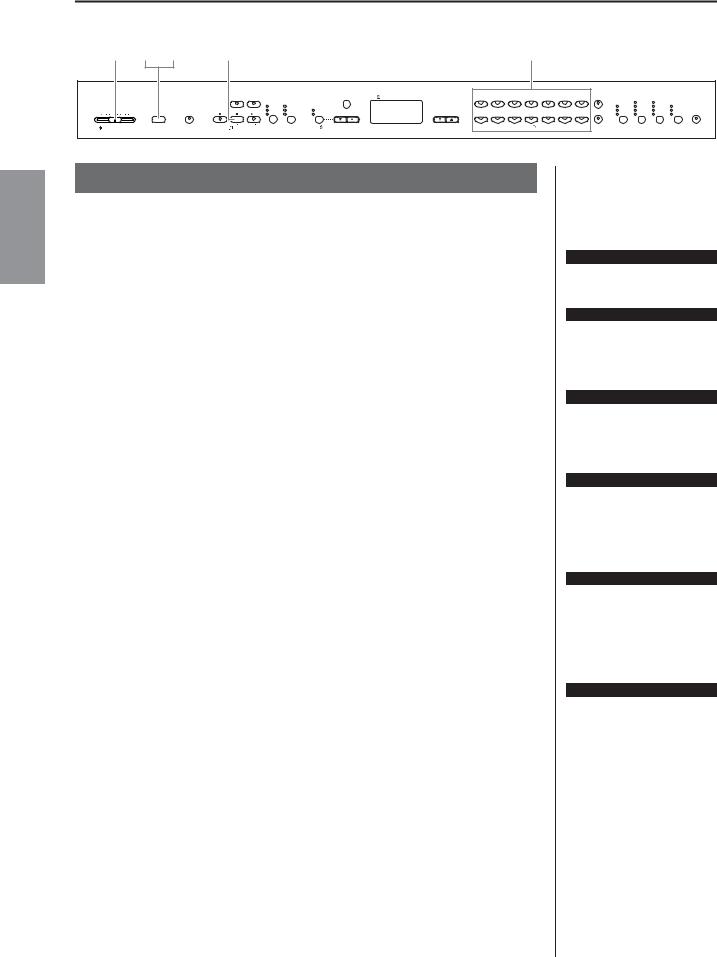
Listening to the Demonstration Tunes
Listening to the Demonstration Tunes
ENGLISH
Demonstration tunes are provided that effectively demonstrate each of the CLP-240/230’s voices.
|
1 |
2 |
4 |
4 |
|
|
|
|
|
|
|
|
|
3 |
|
|
|
|
|
|
|
|
|
|
|
|
|
|
|
|
|
|
|
TEMPO/OTHER VALUE |
GRAND |
GRAND |
E.PIANO |
E.PIANO |
HARPSI- |
E.CLAVI- |
VIBRA- |
|
|
|
|
|
|
|
|
|
|
LEFT |
RIGHT |
|
|
|
ON/OFF |
PIANO1 |
PIANO 2 |
1 |
2 |
CHORD |
CHORD |
PHONE |
VARIATION |
|
|
|
|
|
|
|
|
|
|
|
|
|
|
|
|
|
|
|
|
|
|
|
|
|
|
ROOM |
CHORUS |
|
|
|
|
|
|
|
|
USB |
SAVE/EXP. |
|
|
|
|
|
|
|
|
|
|
|
BRIGHT |
HALL 1 |
PHASER |
HARD |
|
|
|
|
REC |
STOP |
PLAY/PAUSE |
USER |
LOAD |
TEMPO |
METRONOME |
–/ NO +/ YES |
CHURCH |
JAZZ |
|
|
|
WOOD |
|
|
NORMAL |
HALL 2 |
TREMOLO |
MEDIUM |
|
MIN |
MAX |
|
ON |
|
|
PRESET |
FORMAT/DEL. |
FUNCTION# |
|
ORGAN |
ORGAN |
STRINGS |
CHOIR |
GUITAR |
BASS |
E.BASS |
SPLIT |
MELLOW |
STAGE |
ROTARYSP |
SOFT |
ON |
|
|
MASTER VOLUME |
|
|
SYNC START |
|
|
TEMPO / FUNCTION# |
|
|
|
|
|
VOICE |
|
|
|
BRILLIANCE |
REVERB |
EFFECT |
TOUCH |
DDE |
||
|
DEMO |
TRANSPOSE |
SONG |
SONG SELECT |
FILE |
|
|
|
|
|
|
|
|
||||||||||
CLP-240
Procedure
1. Turn the power on.
(In case the power is not turned ON) Press the [POWER] switch. When the power is turned ON, one of the voice button LEDs will light.
Initially set the [MASTER VOLUME] slider about half way between the “MIN” and “MAX” settings. Then, when you start playing, re-adjust the [MASTER VOLUME] slider to the most comfortable listening level.
2. Engage Demo mode.
Press the [DEMO] button to engage Demo mode. The voice button indicators will flash in sequence.
3. Play a Voice demo.
Press one of the voice buttons to start playback of all songs starting from the corresponding voice demo tune — featuring the voice normally selected by that voice button. (If you press the SONG [PLAY/PAUSE] button instead of a voice button, the GRAND PIANO 1 demo tune will begin playback.)
4. Stop the Voice demo and exit from Demo mode.
Press the [DEMO] or SONG [STOP] button.
NOTE
For a list of the demo songs, see page 74.
NOTE
MIDI reception is not possible in Demo Song mode.
Demo song data is not transmitted via the MIDI terminals.
NOTE
Demo mode cannot be engaged during User song recording (page 29) or file operations (page 35).
TERMINOLOGY
Mode:
A mode is a status under which you can execute a certain function. In Demo mode, you can play back demonstration tunes.
NOTE
You cannot adjust the tempo of demo songs.
You cannot use the part cancel function (page 17) or the song A-B repeat function (page 18) in Demo mode.
NOTE
On the CLP-240, you can demo the piano voices with various effects by pressing the [VARIATION] button, then pressing the desired voice button. Refer to the “Piano Voice Demo Description” on page 74 for the complete list of demo sounds for the piano voices with various effects.
14 |
CLP-240/230 Owner’s Manual |
|
|
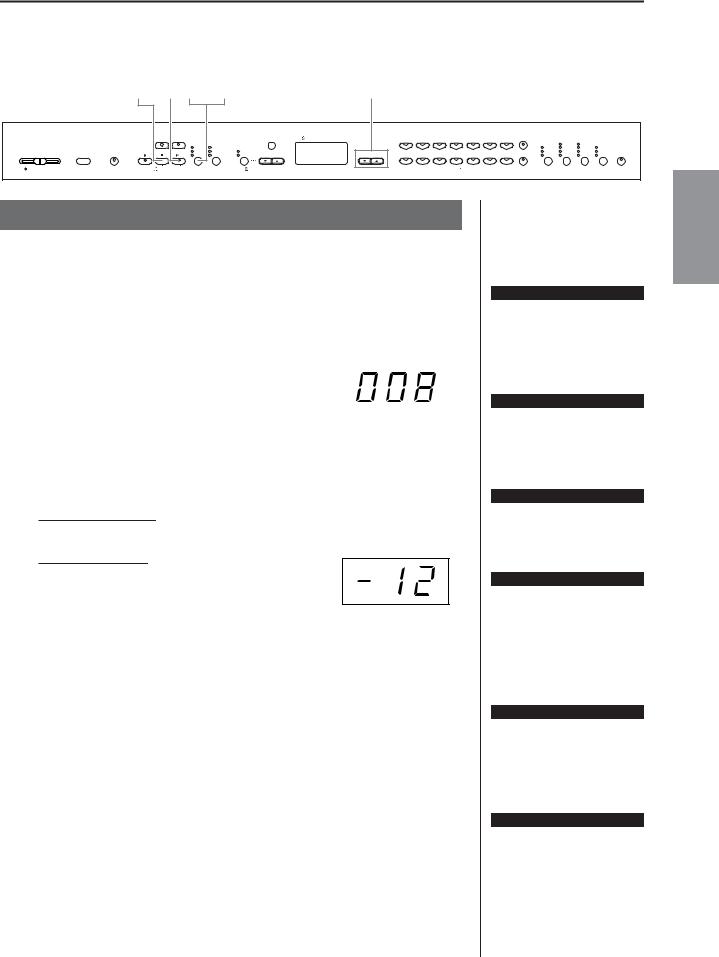
Listening to 50 Piano Preset Songs
Listening to 50 Piano Preset Songs
The Clavinova provides performance data of 50 piano songs. You can simply listen to these songs (page 15) or use them for practice (page 17). You can also refer to the included “50 Greats for the Piano” that contains scores for 50 piano preset songs.
|
|
|
3 2-2 1 |
|
4 |
|
|
2-1 |
|
|
|
|
|
|
|
|
|
|
|
|
|
||
|
|
|
|
|
|
|
|
|
|
TEMPO/OTHER VALUE |
GRAND |
GRAND |
E.PIANO |
E.PIANO |
HARPSI- |
E.CLAVI- |
VIBRA- |
|
|
|
|
|
|
|
|
|
|
LEFT |
RIGHT |
|
|
|
ON/OFF |
PIANO1 |
PIANO 2 |
1 |
2 |
CHORD |
CHORD |
PHONE |
VARIATION |
|
|
|
|
|
|
|
|
|
|
|
|
|
|
|
|
|
|
|
|
|
|
|
|
|
|
ROOM |
CHORUS |
|
|
|
|
|
|
|
|
USB |
SAVE/EXP. |
|
|
|
|
|
|
|
|
|
|
|
BRIGHT |
HALL 1 |
PHASER |
HARD |
|
|
|
|
REC |
STOP |
PLAY/PAUSE |
USER |
LOAD |
TEMPO |
METRONOME |
–/ NO +/ YES |
CHURCH |
JAZZ |
|
|
|
WOOD |
|
|
NORMAL |
HALL 2 |
TREMOLO |
MEDIUM |
|
MIN |
MAX |
|
ON |
|
|
PRESET |
FORMAT/DEL. |
FUNCTION# |
|
ORGAN |
ORGAN |
STRINGS |
CHOIR |
GUITAR |
BASS |
E.BASS |
SPLIT |
MELLOW |
STAGE |
ROTARYSP |
SOFT |
ON |
|
|
MASTER VOLUME |
|
|
SYNC START |
|
|
TEMPO / FUNCTION# |
|
|
|
|
|
VOICE |
|
|
|
BRILLIANCE |
REVERB |
EFFECT |
TOUCH |
DDE |
||
|
DEMO |
TRANSPOSE |
SONG |
SONG SELECT |
FILE |
|
|
|
|
|
|
|
|
||||||||||
CLP-240
Procedure
1. Engage Preset Song mode.
Press the [SONG SELECT] button a few times until the “PRESET” indicator lights.
2. Play any of the 50 preset songs.
2-1 Press the [–/NO], [+/YES] buttons to select the number |
|
|
|
|
|
|
|
|
|
|
|
||
of the tune you want to play (the number will appear |
|
|
|
|
|
|
on the LED display). |
|
|
|
|
|
|
1 – 50: |
Select a preset song number and play only |
|
|
|
|
|
|
|
|
|
|
||
ALL: |
the song. |
song |
|
number |
||
|
||||||
Play all preset songs in sequence. |
|
|
|
|
||
rnd: |
Play all preset songs continuously in random order. |
|
|
|
|
|
2-2 Press the SONG [PLAY/PAUSE] button to start playback.
Adjust the Volume
Use the [MASTER VOLUME] control to adjust the volume.
Adjust the tempo
You can use the [TEMPO/FUNCTION# ▼
▲] buttons to adjust the playback tempo as required. The default tempo can be recalled by simultaneously pressing the [▼] and [▲] buttons.
3. Stop playback.
This produces a relative tempo variation, with a range from “–50” through “0” to “50” at maximum; the range will differ depending on the selected song.
Playback will stop automatically when the selected preset song has finished. To stop the song during playback (or continuous playback), press the SONG [STOP] button. You can also pause playback by pressing the SONG [PLAY/ PAUSE] button.
• To play back another song continuously, see procedure 2 above.
NOTE
Preset Song mode cannot be engaged while the unit is in Demo Song mode (page 14) or during song playback (page 41), User song recording (page 29), or file operations (page 35).
TERMINOLOGY
Song:
On the CLP-240/230, performance data is called a “Song.” This includes demonstration tunes and piano preset tunes.
NOTE
You can play the keyboard along with the preset song. You can change the voice playing on the keyboard.
NOTE
You can adjust the Brilliance control (page 21) and Reverb type (page 21) that is applied to the voice you play on the keyboard and for the preset song playback. You can change the Effect type (page 22) and Touch sensitivity (page 23) for the keyboard voice.
NOTE
The default tempo “0” is automatically selected whenever a new preset song is selected, or when playback of a new preset song begins during “ALL” or “rnd” playback.
NOTE
When you select a different song (or a different song is selected during chained playback), appropriate reverb and effect types will be selected accordingly.
ENGLISH
CLP-240/230 Owner’s Manual |
15 |
|
|

Listening to 50 Piano Preset Songs
4. Exit from Preset Song mode.
Press the [SONG SELECT] button to exit Preset Song mode. The indicator turns off, and the unit returns to normal play mode.
How to use the practice functions
You can turn the leftand right-hand parts on or off as required so you can practice the corresponding part (part cancel function) and continuously repeat a specified phrase within a song (song A-B repeat function). For more information, see pages 17–18.
ENGLISH
16 |
CLP-240/230 Owner’s Manual |
|
|
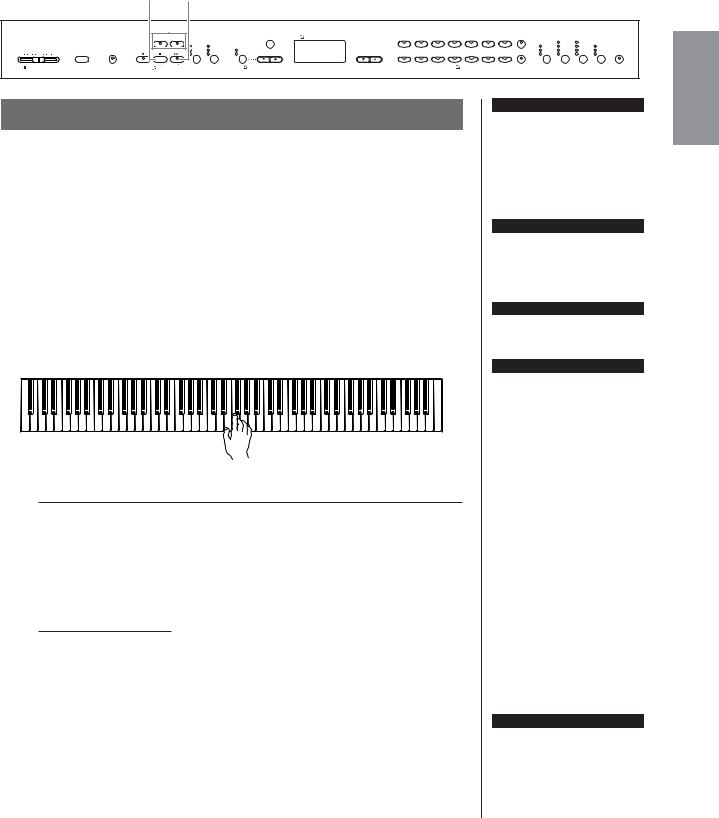
Listening to 50 Piano Preset Songs
 Practicing a One-Hand Part Using 50 Preset Songs (Part Cancel Function)
Practicing a One-Hand Part Using 50 Preset Songs (Part Cancel Function)
The 50 preset songs have separate leftand right-hand parts on individual parts. You can turn the leftand right-hand parts on or off as required so you can practice the corresponding part (the part that is turned off) on the keyboard. The right-hand part is played by [RIGHT] and the left-hand part is played by [LEFT].
|
|
3 1 2 |
|
|
|
|
|
|
|
|
|
|
|
|
|
|
|
|
|
|
|||
|
|
|
|
|
|
|
|
|
TEMPO/OTHER VALUE |
|
GRAND |
GRAND |
E.PIANO |
E.PIANO |
HARPSI- |
E.CLAVI- |
VIBRA- |
|
|
|
|
|
|
|
|
|
LEFT |
RIGHT |
|
|
|
ON/OFF |
|
PIANO1 |
PIANO 2 |
1 |
2 |
CHORD |
CHORD |
PHONE |
VARIATION |
|
|
|
|
|
|
|
|
|
|
|
|
|
|
|
|
|
|
|
|
|
|
|
|
|
|
ROOM |
CHORUS |
|
|
|
|
|
|
|
USB |
SAVE/EXP. |
|
|
|
|
|
|
|
|
|
|
|
|
BRIGHT |
HALL 1 |
PHASER |
HARD |
|
|
|
REC |
STOP |
PLAY/PAUSE |
USER |
LOAD |
TEMPO |
METRONOME |
|
+/ YES |
CHURCH |
JAZZ |
|
|
|
WOOD |
|
|
NORMAL |
HALL 2 |
TREMOLO |
MEDIUM |
|
MIN |
MAX |
ON |
|
|
PRESET |
FORMAT/DEL. |
FUNCTION# |
|
–/ NO |
ORGAN |
ORGAN |
STRINGS |
CHOIR |
GUITAR |
BASS |
E.BASS |
SPLIT |
MELLOW |
STAGE |
ROTARYSP |
SOFT |
ON |
|
MASTER VOLUME |
|
|
SYNC START |
SONG SELECT FILE |
TEMPO / FUNCTION# |
VOICE |
BRILLIANCE REVERB EFFECT TOUCH |
DDE |
DEMO |
TRANSPOSE |
SONG |
CLP-240
Procedure
1. Turn off the playback part you wish to practice.
After you select a song to practice, press the [RIGHT] or [LEFT] button to turn off the corresponding part.
When you first select a song, both [RIGHT] and [LEFT] indicators light up, indicating that you can play back both parts. When you press one of the buttons to turn off playback, the corresponding button indicator turns off and the corresponding part playback is muted.
• Pressing the buttons repeatedly toggles playback between on and off.
2.Start playback and playing.
Press the SONG [PLAY/PAUSE] button to start playback. Play the part you just turned off.
Starting playback automatically as you start playing the keyboard (Sync Start)
When the Sync Start function is engaged, playback of the selected preset song will begin automatically as soon as you start playing on the keyboard.
To engage the Sync Start function, simultaneously hold down the SONG [STOP] and press the [PLAY/PAUSE] button.
(Repeat the previous operation to disengage the Sync Start function.) Playback will then start as soon as you begin playing on the keyboard.
Left Pedal Play/Pause
The left pedal can be assigned to play and pause preset song playback via the “Left Pedal Mode” function described on page 51.
3. Stop playback.
When playback is complete, it automatically stops and the Clavinova locates the top of the song. If you wish to stop playback in the middle of a song, press the SONG [STOP] button. You can also pause playback by pressing the SONG [PLAY/PAUSE] button.
NOTE
Appropriate channels in the song will automatically be assigned to [RIGHT] and [LEFT]. Therefore, [RIGHT] may be assigned to a part other than channel 1, or [LEFT] to a part other than channel 2.
NOTE
The Preset Song Part Cancel function cannot be used during “ALL” or “rnd” (page 15) playback.
NOTE
The parts can be turned on or off even during playback.
NOTE
The “Song Part Cancel Volume” function described on page 52 can be used to set the canceled part so that it plays at a volume from “0” (no sound) to “20”. The normal setting is “5”.
NOTE
Both parts are automatically turned ON whenever a new song is selected.
ENGLISH
CLP-240/230 Owner’s Manual |
17 |
|
|
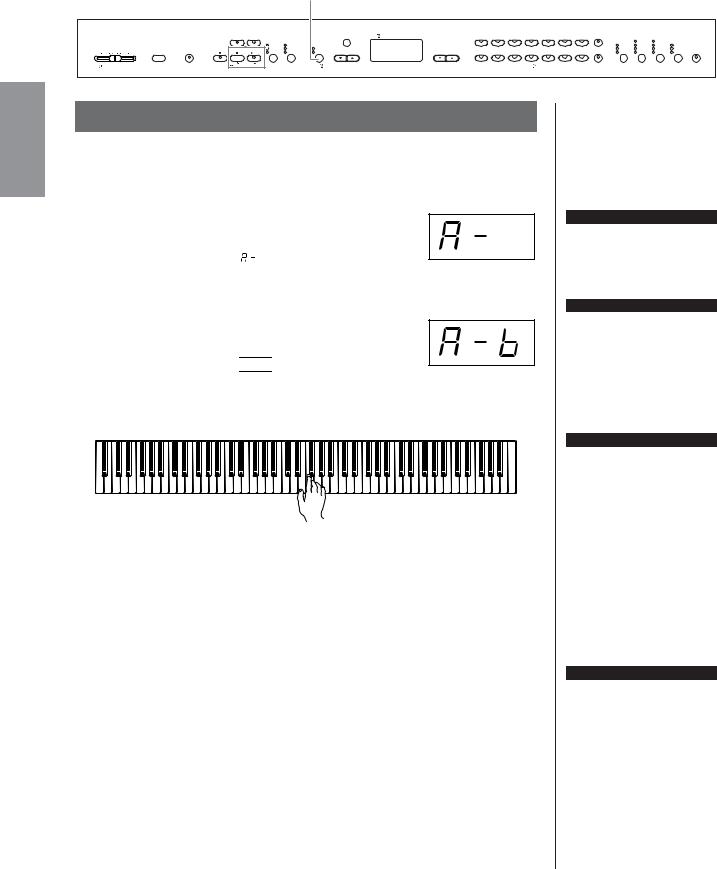
Listening to 50 Piano Preset Songs
 A-B Repeat for 50 Preset Songs
A-B Repeat for 50 Preset Songs
The A-B Repeat function can be used to continuously repeat a specified phrase within a preset song. Combined with the Part Cancel function described below, this provides an excellent way to practice difficult phrases.
|
|
|
|
2 |
|
1 |
|
|
|
|
|
|
|
|
|
|
|
|
|
|
|
|
|
|
|
|
|
|
|
|
|
|
|
TEMPO/OTHER VALUE |
GRAND |
GRAND |
E.PIANO |
E.PIANO |
HARPSI- |
E.CLAVI- |
VIBRA- |
|
|
|
|
|
|
|
|
|
|
LEFT |
RIGHT |
|
|
|
ON/OFF |
PIANO1 |
PIANO 2 |
1 |
2 |
CHORD |
CHORD |
PHONE |
VARIATION |
|
|
|
|
|
|
|
|
|
|
|
|
|
|
|
|
|
|
|
|
|
|
|
|
|
|
ROOM |
CHORUS |
|
|
|
|
|
|
|
|
USB |
SAVE/EXP. |
|
|
|
|
|
|
|
|
|
|
|
BRIGHT |
HALL 1 |
PHASER |
HARD |
|
|
|
|
REC |
STOP |
PLAY/PAUSE |
USER |
LOAD |
TEMPO |
METRONOME |
–/ NO +/ YES |
CHURCH |
JAZZ |
|
|
|
WOOD |
|
|
NORMAL |
HALL 2 |
TREMOLO |
MEDIUM |
|
MIN |
MAX |
|
ON |
|
|
PRESET |
FORMAT/DEL. |
FUNCTION# |
|
ORGAN |
ORGAN |
STRINGS |
CHOIR |
GUITAR |
BASS |
E.BASS |
SPLIT |
MELLOW |
STAGE |
ROTARYSP |
SOFT |
ON |
|
|
MASTER VOLUME |
|
|
SYNC START |
|
|
TEMPO / FUNCTION# |
|
|
|
|
|
VOICE |
|
|
|
BRILLIANCE |
REVERB |
EFFECT |
TOUCH |
DDE |
||
|
DEMO |
TRANSPOSE |
SONG |
SONG SELECT |
FILE |
|
|
|
|
|
|
|
|
||||||||||
CLP-240
ENGLISH
Procedure
1. Specify the beginning (A) and the end (B) of the phrase, and start practicing.
Select and play a preset song, then press the [TEMPO/ FUNCTION#] button at the beginning of the phrase you want to repeat.
This sets the “A” point ( |
|
will appear on the dis- |
play). |
|
|
To specify the end (B) of the phrase, press the [TEMPO/ FUNCTION#] button a second time at the end of the phrase.
This sets the “B” point (





 will appear on the display).
will appear on the display).
At this point, repeat playback will begin between the specified A and B points.
2. Stop playback.
Press the SONG [STOP] button to stop playback while retaining the specified A and B points. A-B repeat playback will resume if you press the SONG [PLAY/ PAUSE] button.
To cancel the A and B points, press the [TEMPO/FUNCTION#] button once.
NOTE
The A-B Repeat function cannot be used during “ALL” or “rnd” (page 15) playback.
NOTE
•To set the “A” point at the very beginning of the song, press the [TEMPO/FUNCTION#] button before starting playback.
•You can have the B point automatically be set to the song’s end, by setting the A point and letting the song play to the end.
NOTE
An automatic lead-in (to help guide you into the phrase) starts at the A point of the song.
NOTE
The A and B points are automatically canceled when a new song is selected.
18 |
CLP-240/230 Owner’s Manual |
|
|
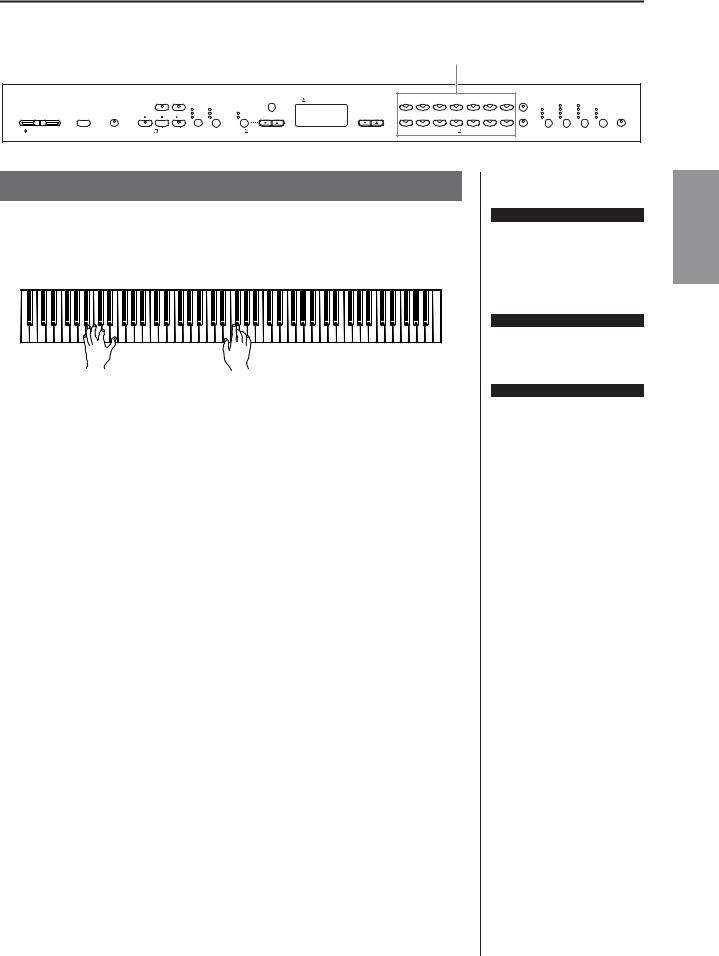
Selecting & Playing Voices
Selecting & Playing Voices
 Selecting Voices
Selecting Voices
|
|
|
|
|
|
|
|
|
|
|
|
|
Voice buttons |
|
|
|
|
|
|
|
|||
|
|
|
|
|
|
|
|
|
|
TEMPO/OTHER VALUE |
GRAND |
GRAND |
E.PIANO |
E.PIANO |
HARPSI- |
E.CLAVI- |
VIBRA- |
VARIATION |
|
|
|
|
|
|
|
|
|
LEFT |
RIGHT |
|
|
|
ON/OFF |
PIANO1 |
PIANO 2 |
1 |
2 |
CHORD |
CHORD |
PHONE |
|
|
|
|
|
||
|
|
|
|
|
|
|
|
|
|
|
|
|
|
|
|
|
|
|
|
ROOM |
CHORUS |
|
|
|
|
|
|
|
|
USB |
SAVE/EXP. |
|
|
|
|
|
|
|
|
|
|
|
BRIGHT |
HALL 1 |
PHASER |
HARD |
|
|
|
|
REC |
STOP |
PLAY/PAUSE |
USER |
LOAD |
TEMPO |
METRONOME |
–/ NO +/ YES |
CHURCH |
JAZZ |
|
|
|
WOOD |
|
|
NORMAL |
HALL 2 |
TREMOLO |
MEDIUM |
|
MIN |
MAX |
|
ON |
|
|
PRESET |
FORMAT/DEL. |
FUNCTION# |
|
ORGAN |
ORGAN |
STRINGS |
CHOIR |
GUITAR |
BASS |
E.BASS |
SPLIT |
MELLOW |
STAGE |
ROTARYSP |
SOFT |
ON |
|
|
MASTER VOLUME |
|
|
SYNC START |
|
|
TEMPO / FUNCTION# |
|
|
|
|
|
VOICE |
|
|
|
BRILLIANCE |
REVERB |
EFFECT |
TOUCH |
DDE |
||
|
DEMO |
TRANSPOSE |
SONG |
SONG SELECT |
FILE |
|
|
|
|
|
|
|
|
||||||||||
CLP-240
Procedure
Select the desired voice by pressing one of the Voice buttons.
Then, when you start playing, re-adjust the [MASTER VOLUME] slider for the most comfortable listening level.
NOTE
To learn characteristics of the voices, listen to demo songs for each voice (page 14). Refer to “Preset Voice List” on page 71 for more information on the characteristics of each preset voice.
TERMINOLOGY
Voice:
On the Clavinova, a voice means a “tone” or “tonal color.”
NOTE
You can control the loudness of a voice by adjusting the force with which you strike the keys, although different playing styles (touch sensitivities) have little or no effect with certain musical instruments.
Refer to “Preset Voice List” on page 71.
ENGLISH
CLP-240/230 Owner’s Manual |
19 |
|
|
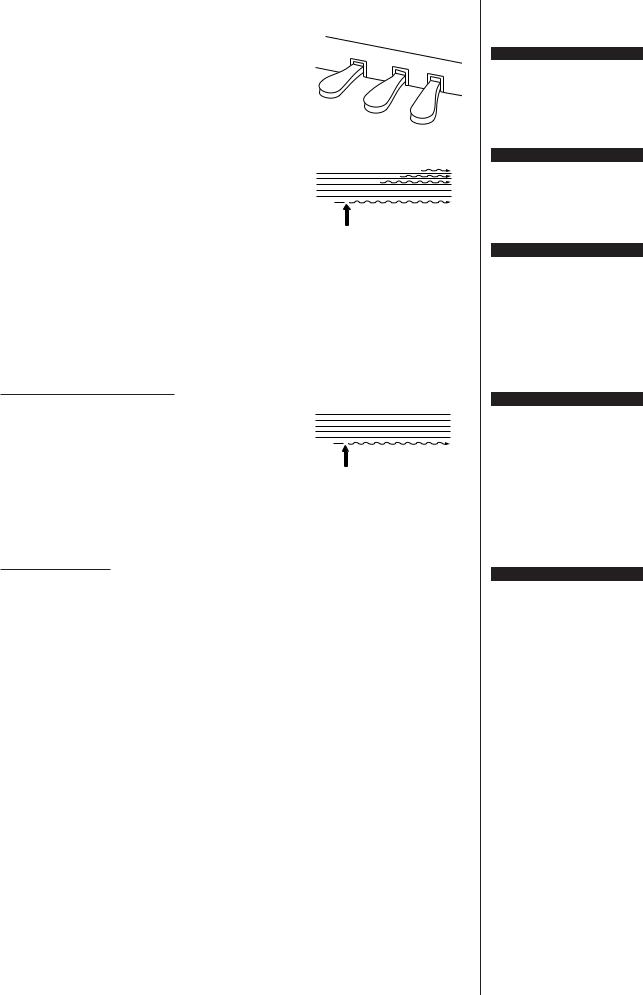
Selecting & Playing Voices
 Using the Pedals
Using the Pedals
The Clavinova has three foot pedals that produce a range of expressive effects similar to those produced by the pedals on an acoustic piano.
|
|
Damper (Right) Pedal |
|
|
|
The damper pedal functions in the same way as a |
|
|
|
damper pedal on an acoustic piano. When the damper |
|
|
|
pedal is pressed, notes sustain longer. Releasing the pedal |
|
|
|
immediately stops (damps) any sustained notes. |
|
|
|||
ENGLISH |
|
When you select the GRAND PIANO 1 voice on the CLP- |
|
|
240, pressing the damper pedal activates the instrument’s |
||
|
|
||
|
|
special “Sustain Samples” to accurately recreate the |
|
|
|
unique resonance of an acoustic grand piano’s sound- |
|
|
|
board and strings. A “half-pedal” effect lets you use the |
|
|
|
damper pedal to create partial sustain effects, depending |
|
|
|
on how far down you press the pedal. |
|
|
|
|
|
|
|
|
|
|
|
|
|
|
|
|
|
|
|
|
|
When you press the damper pedal here, the notes you play before you release the pedal have a longer sustain.
Sostenuto (Center) Pedal
If you play a note or chord on the keyboard and press the sostenuto pedal while the note(s) are held, those notes will sustain as long as you hold the pedal (as if the damper pedal had been pressed) but all subsequently played notes will not be sustained. This makes it possible to sustain a chord, for example, while other notes are played “staccato.”
Soft (Left) Pedal
|
|
|
|
|
|
|
|
|
|
|
|
|
|
|
|
|
|
|
|
When you press the sostenuto pedal here while holding the note, the note will sustain as long as you hold the pedal.
The soft pedal reduces the volume and slightly changes the timbre of notes played while the pedal is pressed. The soft pedal will not affect notes that are already playing when it is pressed.
NOTE
If the damper pedal doesn’t work, make sure that the pedal cord is properly plugged into the main unit (page 67).
NOTE
The depth of the effect produced by the “Sustain Samples” can be adjusted via the “Pedal Functions” (page 51) in Function mode.
NOTE
When the DDE effect is on, you can hear a simulation of the sustain sound of the damper pedal on a grand piano, as you press the damper pedal and play the keyboard (page 22).
NOTE
Organ, string and choir voices will continue to sound for as long as the sostenuto pedal is depressed.
NOTE
The left pedal can be assigned to song play/pause operation or variation function (CLP-240) via the “Left Pedal Mode” described on page 51.
20 |
CLP-240/230 Owner’s Manual |
|
|
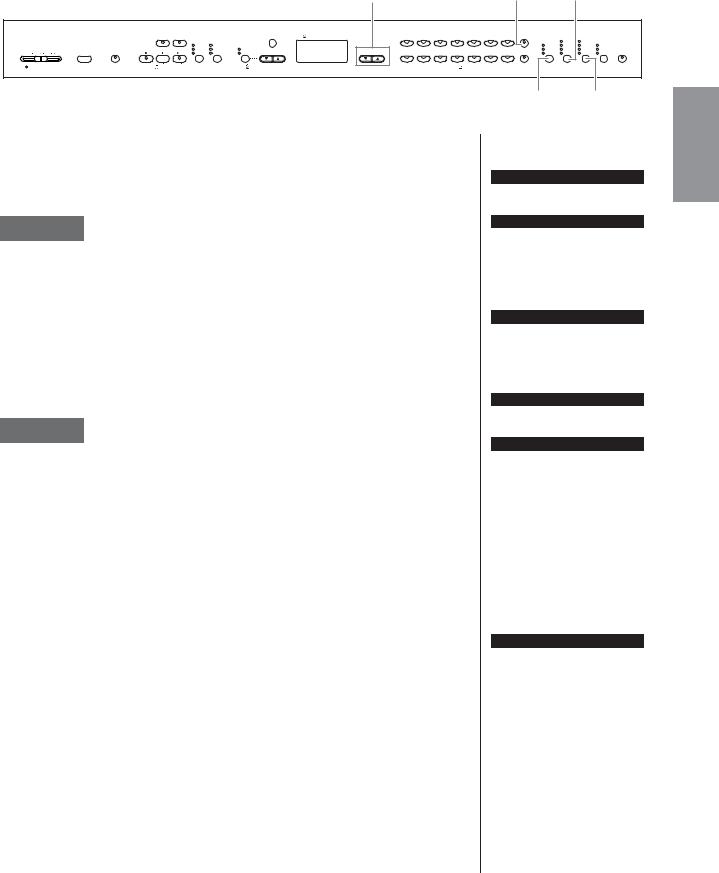
Selecting & Playing Voices
 Adding Variations to the Sound – [VARIATION] (CLP240)/[BRILLIANCE]/[REVERB]/[EFFECT]/[DDE] (CLP-240)
Adding Variations to the Sound – [VARIATION] (CLP240)/[BRILLIANCE]/[REVERB]/[EFFECT]/[DDE] (CLP-240)
[–/NO] [+/YES] |
[VARIATION] |
[REVERB] |
buttons |
button |
button |
|
|
|
|
|
|
|
|
|
|
TEMPO/OTHER VALUE |
|
GRAND |
GRAND |
E.PIANO |
E.PIANO |
HARPSI- |
E.CLAVI- |
VIBRA- |
|
|
|
|
|
|
|
|
|
|
LEFT |
RIGHT |
|
|
|
ON/OFF |
|
PIANO1 |
PIANO 2 |
1 |
2 |
CHORD |
CHORD |
PHONE |
VARIATION |
|
|
|
|
|
|
|
|
|
|
|
|
|
|
|
|
|
|
|
|
|
|
|
|
|
|
|
ROOM |
CHORUS |
|
|
|
|
|
|
|
|
USB |
SAVE/EXP. |
|
|
|
|
|
|
|
|
|
|
|
|
BRIGHT |
HALL 1 |
PHASER |
HARD |
|
|
|
|
REC |
STOP |
PLAY/PAUSE |
USER |
LOAD |
TEMPO |
METRONOME |
|
–/ NO +/ YES |
CHURCH |
JAZZ |
|
|
|
WOOD |
|
|
NORMAL |
HALL 2 |
TREMOLO |
MEDIUM |
|
MIN |
MAX |
|
ON |
|
|
PRESET |
FORMAT/DEL. |
FUNCTION# |
|
|
ORGAN |
ORGAN |
STRINGS |
CHOIR |
GUITAR |
BASS |
E.BASS |
SPLIT |
MELLOW |
STAGE |
ROTARYSP |
SOFT |
ON |
|
|
MASTER VOLUME |
|
|
SYNC START |
|
|
TEMPO / FUNCTION# |
|
|
|
|
|
|
VOICE |
|
|
|
BRILLIANCE |
REVERB |
EFFECT |
TOUCH |
DDE |
||
|
DEMO |
TRANSPOSE |
SONG |
SONG SELECT |
FILE |
|
|
|
|
|
|
|
|
|
||||||||||
CLP-240
[BRILLIANCE] [EFFECT] button button
[VARIATION] (CLP-240)
Lets you alter another aspect of the effect, depending on the selected type.
Refer to “Preset Voice List” on page 71 for more information on the characteristics of each variation.
Procedure
Pressing the [VARIATION] or selected voice button toggles the variation on and off. The indicator lights (ON) each time the [VARIATION] button is pressed.
[BRILLIANCE]
This control can be used to change the tonality or “timbre” of the sound output.
BRIGHT: Bright tone
NORMAL: Standard tone
MELLOW: Soft and mellow tone
Procedure
To select a brilliance type, press the [BRILLIANCE] button a few times until the indicator corresponding to the desired type lights (the indicator lights in sequence each time you press the [BRILLIANCE] button). Brilliance can be selected among five types. When two adjacent indicators are lit, the type that is between the two indicated types is selected. For example, when both NORMAL and MELLOW are lit, the brilliance setting between NORMAL and MELLOW is selected. This parameter affects the entire sound of the instrument.
[REVERB]
This control enables you to select various digital reverb effects that would add extra depth and expression to the sound to create a realistic acoustic ambience.
OFF: When no reverb effect is selected, no REVERB indicator is lit.
ROOM: This setting adds a continuous reverb effect to the sound, similar to the acoustic reverberation you would hear in a room.
HALL 1: For a “bigger” reverb sound, use the HALL 1 setting. This effect simulates the natural reverberation of a small-size concert hall.
HALL 2: For a truly spacious reverb sound, use the HALL 2 setting. This effect simulates the natural reverberation of a large concert hall.
STAGE: Simulates the reverb of a stage environment.
NOTE
Normal setting = OFF
TERMINOLOGY
Normal setting:
The “Normal setting” refers to the default setting (factory setting) obtained when you first turn on the power to the Clavinova.
NOTE
The left pedal can be assigned to ON or OFF the variation via the “Left Pedal Mode” function described on page 51 (CLP-240).
NOTE
Normal setting = NORMAL
NOTE
When the BRILLIANCE is set to BRIGHT, the overall sound will be slightly louder. If the MASTER VOLUME is set at a high level the sound may become distorted. If so, lower the MASTER VOLUME level.
NOTE
The default reverb type (including OFF) and depth settings are different for each voice.
ENGLISH
CLP-240/230 Owner’s Manual |
21 |
|
|
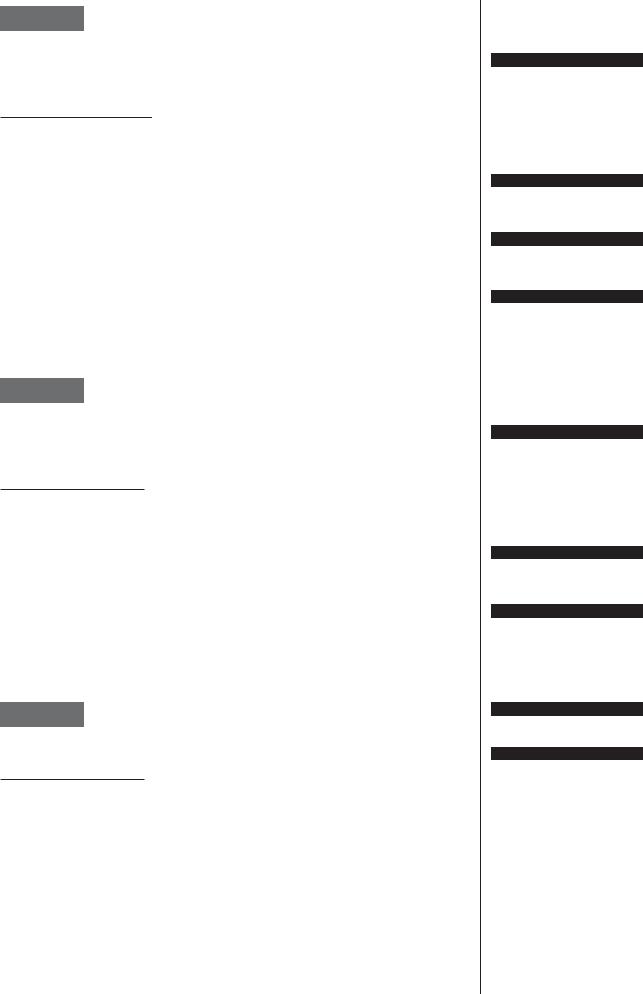
Selecting & Playing Voices
Procedure
Pressing the [REVERB] button repeatedly toggles the reverb on and off.
The indicators light in sequence each time the [REVERB] button is pressed. No effect is produced when all indicators are off.
Adjusting Reverb Depth
Adjust the reverb depth for the selected voice by using the [–/NO] [+/YES] buttons while holding the [REVERB] button. The depth range is from 0 through 20. The current depth setting appears on the LED display while the [REVERB] button is held.
ENGLISH |
[EFFECT] |
|
OFF: |
When no effect is selected, no EFFECT indicator is lit. |
|
|
The [EFFECT] button allows you to select an effect to give your sound greater depth and |
|
|
animation. |
|
|
CHORUS: |
A shimmering, broadening effect |
|
PHASER: |
Adds a sweeping effect to the sound. |
|
||
TREMOLO: Tremolo effect
ROTARY SP: Adds the vibrato effect of a rotary speaker.
Procedure
To select an effect type, press the [EFFECT] button a few times until the indicator corresponding to the desired type lights (the indicators light in sequence each time you press the [EFFECT] button). No effect is produced when all indicators are off.
Adjusting Effect Depth
You can adjust the effect depth for the selected voice by using the [–/NO] and [+/YES] buttons while holding the [EFFECT] button.
The depth range is from 0 through 20. The current depth setting appears on the LED display while the [EFFECT] button is held.
[DDE] (CLP-240)
The DDE (Dynamic Damper Effect) lets you hear a simulation of the sustain sound of the damper pedal on a grand piano, as you press the damper pedal and play the keyboard. This effect is applied to the entire sound of the instrument.
Procedure
Pressing the [DDE] button repeatedly toggles the DDE on and off.
Adjusting DDE Depth
You can adjust the DDE depth by using the [–/NO] and [+/YES] buttons while holding the [DDE] button.
The depth range is from 0 through 20. The current depth setting appears on the LED display while the [DDE] button is held.
NOTE
Releasing the [REVERB] button changes the reverb type.
If you are changing the reverb depth by holding the [REVERB] button, pressing the [REVERB] button will not change the reverb type.
NOTE
Depth 0: no effect
Depth 20: maximum reverb depth
NOTE
Default depth settings are different for each voice.
NOTE
The default effect type (including OFF) and depth settings are different for each voice.
NOTE
Releasing the [EFFECT] button changes the effect type.
If you are changing the depth settings by holding the [EFFECT] button, pressing the [EFFECT] button will not change the effect type.
NOTE
Depth 0: no effect
Depth 20: maximum effect depth
NOTE
Default depth settings are different for each voice.
NOTE
Normal setting = ON
NOTE
Depth 0: no effect
Depth 20: maximum DDE depth
22 |
CLP-240/230 Owner’s Manual |
|
|

Selecting & Playing Voices
 Touch Sensitivity – [TOUCH]
Touch Sensitivity – [TOUCH]
You can select four different types of keyboard touch sensitivity — HARD, MEDIUM, SOFT or FIXED
— to match different playing styles and preferences.
HARD: Requires that the keys be played quite hard to produce maximum loudness.
MEDIUM: Produces a fairly “standard” keyboard response.
SOFT: Allows maximum loudness to be produced with relatively light key pressure.
FIXED: All notes are produced at the same volume no matter how hard the keyboard is played. (No indicators are lit.) The fixed volume can be changed.
NOTE
This setting does not change the weight of the keyboard.
NOTE
Normal setting = MEDIUM
NOTE
The touch sensitivity type will become the common setting for all voices. However, the touch sensitivity settings may have little or no effect with certain voices that are not normally responsive to keyboard dynamics. (Refer to the “Preset Voice List” on
page 71.)
|
|
|
|
|
|
|
|
|
[–/NO] [+/YES] buttons |
|
|
|
|
|
|
[TOUCH] button |
||||||
|
|
|
|
|
|
|
|
|
TEMPO/OTHER VALUE |
GRAND |
GRAND |
E.PIANO |
E.PIANO |
HARPSI- |
E.CLAVI- |
VIBRA- |
|
|
|
|
|
|
|
|
|
|
LEFT |
RIGHT |
|
|
ON/OFF |
PIANO1 |
PIANO 2 |
1 |
2 |
CHORD |
CHORD |
PHONE |
VARIATION |
|
|
|
|
|
|
|
|
|
|
|
|
|
|
|
|
|
|
|
|
|
|
|
|
|
ROOM |
CHORUS |
|
|
|
|
|
|
|
USB |
SAVE/EXP. |
|
|
|
|
|
|
|
|
|
|
|
BRIGHT |
HALL 1 |
PHASER |
HARD |
|
|
|
|
REC |
STOP |
PLAY/PAUSE USER |
LOAD |
TEMPO |
METRONOME |
–/ NO +/ YES |
CHURCH |
JAZZ |
|
|
|
WOOD |
|
|
NORMAL |
HALL 2 |
TREMOLO |
MEDIUM |
|
MIN |
MAX |
|
ON |
|
PRESET |
FORMAT/DEL. |
FUNCTION# |
|
ORGAN |
ORGAN |
STRINGS |
CHOIR |
GUITAR |
BASS |
E.BASS |
SPLIT |
MELLOW |
STAGE |
ROTARYSP |
SOFT |
ON |
|
|
MASTER VOLUME |
|
|
SYNC START |
|
TEMPO / FUNCTION# |
|
|
|
|
|
VOICE |
|
|
|
BRILLIANCE |
REVERB |
EFFECT |
TOUCH |
DDE |
||
|
DEMO |
TRANSPOSE |
SONG |
SONG SELECT |
FILE |
|
|
|
|
|
|
|
|
|||||||||
CLP-240
ENGLISH
Procedure
To select a touch sensitivity type press the [TOUCH] button a few times until the indicator corresponding to the desired type lights (the indicators light in sequence each time the [TOUCH] button is pressed). No indicator is lit when “FIXED” is selected.
Changing the volume when FIXED is selected |
|
When you select FIXED, you can set the volume for notes |
|
played in FIXED mode by using the [–/NO] and [+/YES] but- |
|
tons while you hold the [TOUCH] button. The current vol- |
|
ume level appears on the display. The volume range is from 1 |
|
through 127. The default setting is 64. |
volume range |
NOTE
1: minimum volume 127: maximum volume
NOTE
The touch volume set in FIXED mode will become the common setting for all voices.
NOTE
Releasing the [TOUCH] button changes the touch type.
If you are changing the volume by holding the [TOUCH] button, pressing the [TOUCH] button will not change the touch sensitivity type. (FIXED mode will remain selected.)
CLP-240/230 Owner’s Manual |
23 |
|
|
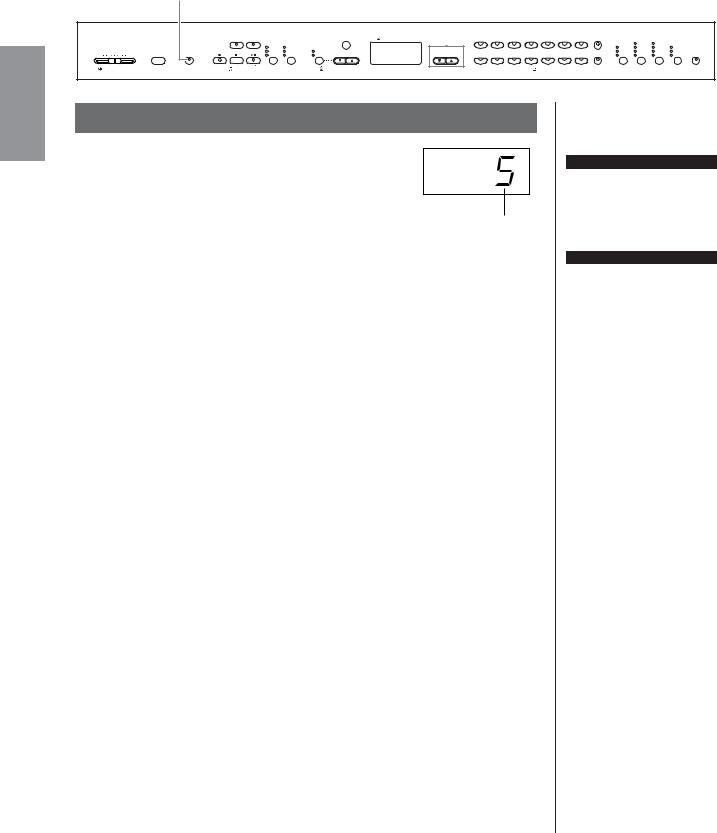
Selecting & Playing Voices
 Transposition – [TRANSPOSE]
Transposition – [TRANSPOSE]
The Clavinova’s Transpose function makes it possible to shift the pitch of the entire keyboard up or down in semitone intervals to facilitate playing in difficult key signatures, and to let you easily match the pitch of the keyboard to the range of a singer or other instruments. For example, if you set the transposition amount to “5,” playing key C produces pitch F. In this way, you can play a song as though it were in C major, and the Clavinova will transpose it to the key of F.
[TRANSPOSE] button |
[–/NO] [+/YES] buttons |
ENGLISH
|
|
|
|
|
|
|
|
|
|
TEMPO/OTHER VALUE |
|
GRAND |
GRAND |
E.PIANO |
E.PIANO |
HARPSI- |
E.CLAVI- |
VIBRA- |
|
|
|
|
|
|
|
|
|
|
LEFT |
RIGHT |
|
|
|
ON/OFF |
|
PIANO1 |
PIANO 2 |
1 |
2 |
CHORD |
CHORD |
PHONE |
VARIATION |
|
|
|
|
|
|
|
|
|
|
|
|
|
|
|
|
|
|
|
|
|
|
|
|
|
|
|
ROOM |
CHORUS |
|
|
|
|
|
|
|
|
USB |
SAVE/EXP. |
|
|
|
|
|
|
|
|
|
|
|
|
BRIGHT |
HALL 1 |
PHASER |
HARD |
|
|
|
|
REC |
STOP |
PLAY/PAUSE |
USER |
LOAD |
TEMPO |
METRONOME |
|
–/ NO +/ YES |
CHURCH |
JAZZ |
|
|
|
WOOD |
|
|
NORMAL |
HALL 2 |
TREMOLO |
MEDIUM |
|
MIN |
MAX |
|
ON |
|
|
PRESET |
FORMAT/DEL. |
FUNCTION# |
|
|
ORGAN |
ORGAN |
STRINGS |
CHOIR |
GUITAR |
BASS |
E.BASS |
SPLIT |
MELLOW |
STAGE |
ROTARYSP |
SOFT |
ON |
|
|
MASTER VOLUME |
|
|
SYNC START |
|
|
TEMPO / FUNCTION# |
|
|
|
|
|
|
VOICE |
|
|
|
BRILLIANCE |
REVERB |
EFFECT |
TOUCH |
DDE |
||
|
DEMO |
TRANSPOSE |
SONG |
SONG SELECT |
FILE |
|
|
|
|
|
|
|
|
|
||||||||||
CLP-240
Procedure
Use the [–/NO] and [+/YES] button while holding the |
|
[TRANSPOSE] button to transpose down or up as required. |
|
The amount of transposition appears on the LED display |
|
while the [TRANSPOSE] button is held. The default transpose |
|
setting is “0”. |
transposition |
The [TRANSPOSE] button indicator remains lit when a transpose setting other than “0” is selected. Every time the [TRANSPOSE] button is pressed after that switches the transpose function ON or OFF.
TERMINOLOGY
Transpose:
Changing the key signature of a song. On the Clavinova, transposing shifts the pitch of the entire keyboard.
NOTE
The transposition range: –12: –12 semitones (down one
octave) 0: normal pitch
12: 12 semitones (up one octave)
24 |
CLP-240/230 Owner’s Manual |
|
|
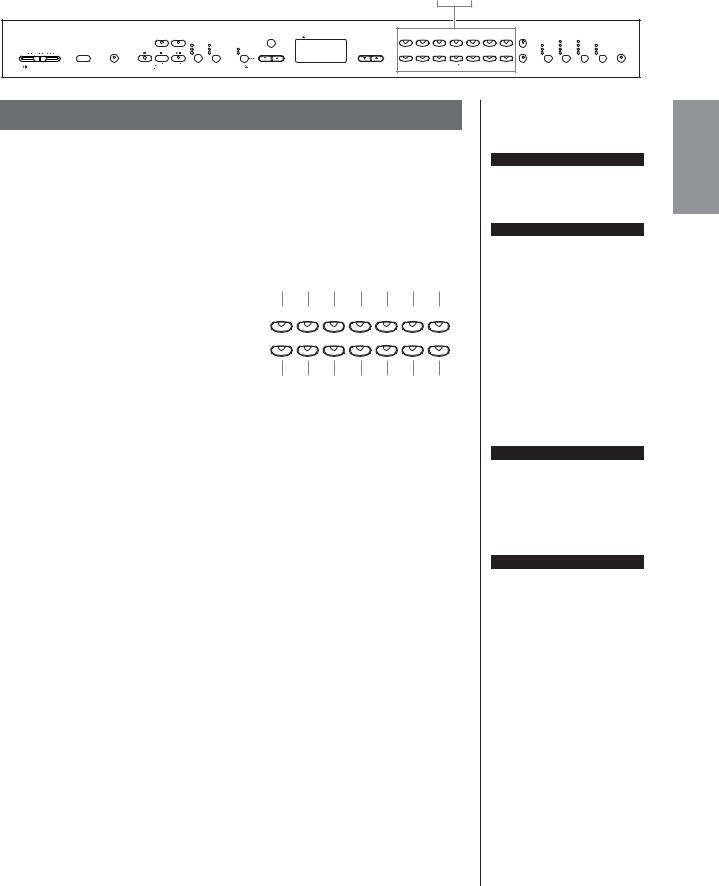
Selecting & Playing Voices
 Combining Two Voices (Dual mode)
Combining Two Voices (Dual mode)
You can play two voices simultaneously across the entire range of the keyboard. In this way, you can simulate a melody duet or combine two similar voices to create a thicker sound.
|
|
|
|
|
|
|
|
|
|
|
|
|
1 |
|
2 |
|
|
|
|
|
|
|
|
|
|
|
|
|
|
|
|
|
|
TEMPO/OTHER VALUE |
GRAND |
GRAND |
E.PIANO |
E.PIANO |
HARPSI- |
E.CLAVI- |
VIBRA- |
|
|
|
|
|
|
|
|
|
|
LEFT |
RIGHT |
|
|
|
ON/OFF |
PIANO1 |
PIANO 2 |
1 |
2 |
CHORD |
CHORD |
PHONE |
VARIATION |
|
|
|
|
|
|
|
|
|
|
|
|
|
|
|
|
|
|
|
|
|
|
|
|
|
|
ROOM |
CHORUS |
|
|
|
|
|
|
|
|
USB |
SAVE/EXP. |
|
|
|
|
|
|
|
|
|
|
|
BRIGHT |
HALL 1 |
PHASER |
HARD |
|
|
|
|
REC |
STOP |
PLAY/PAUSE |
USER |
LOAD |
TEMPO |
METRONOME |
–/ NO +/ YES |
CHURCH |
JAZZ |
|
|
|
WOOD |
|
|
NORMAL |
HALL 2 |
TREMOLO |
MEDIUM |
|
MIN |
MAX |
|
ON |
|
|
PRESET |
FORMAT/DEL. |
FUNCTION# |
|
ORGAN |
ORGAN |
STRINGS |
CHOIR |
GUITAR |
BASS |
E.BASS |
SPLIT |
MELLOW |
STAGE |
ROTARYSP |
SOFT |
ON |
|
|
MASTER VOLUME |
|
|
SYNC START |
|
|
TEMPO / FUNCTION# |
|
|
|
|
|
VOICE |
|
|
|
BRILLIANCE |
REVERB |
EFFECT |
TOUCH |
DDE |
||
|
DEMO |
TRANSPOSE |
SONG |
SONG SELECT |
FILE |
|
|
|
|
|
|
|
|
||||||||||
CLP-240
Procedure
1. Engage Dual mode.
Press two voice buttons at the same time (or press one voice button while holding another). The voice indicators of both selected voices will light when Dual mode is active.
•According to the voice numbering priority shown in the diagram on the right, the lower value voice number will be designated as Voice 1 (the other voice will be designated as Voice 2).
Voice numbering priority
1 |
2 |
3 |
4 |
5 |
6 |
7 |
GRAND |
GRAND |
E.PIANO |
E.PIANO |
HARPSI- |
E.CLAVI- |
VIBRA- |
PIANO1 |
PIANO 2 |
1 |
2 |
CHORD |
CHORD |
PHONE |
CHURCH |
JAZZ |
STRINGS |
|
GUITAR |
WOOD |
E.BASS |
ORGAN |
ORGAN |
CHOIR |
BASS |
 VOICE
VOICE
8 |
9 |
10 |
11 |
12 |
13 |
14 |
The CLP-240/230 Function mode provides access to a number of other Dual mode functions, such as volume balance setting or octave setting (page 49). (If you do not set Dual mode functions, the appropriate setting will be set in each voice by default.)
2. Exit Dual mode and return to normal play mode.
To return to the normal single-voice play mode, press any single voice button.
NOTE (CLP-240)
Dual and Split (page 26) modes cannot be engaged at the same time.
NOTE
[VARIATION] in Dual Mode (CLP-240)
The [VARIATION] button’s indicator will light if the variation is engaged for either or both of the Dual mode voices. While Dual mode is engaged, the [VARIATION] button can be used to turn the variation for both voices on or off. To turn the variation on or off for only one of the voices, hold the voice button for the other voice and press the button of the voice for which you want to change the variation.
NOTE
[REVERB] in Dual Mode
The reverb type assigned to Voice 1 will take priority over the other. (If the reverb is set to OFF, Voice 2 reverb type will be in effect.)
NOTE
[EFFECT] in Dual Mode
Depending on the conditions, one effect type may take priority over the other. Depth will be decided according to the depth default value of the voice combination. However, using function F3 (page 49) you can adjust the depth value for each voice to your liking.
ENGLISH
CLP-240/230 Owner’s Manual |
25 |
|
|
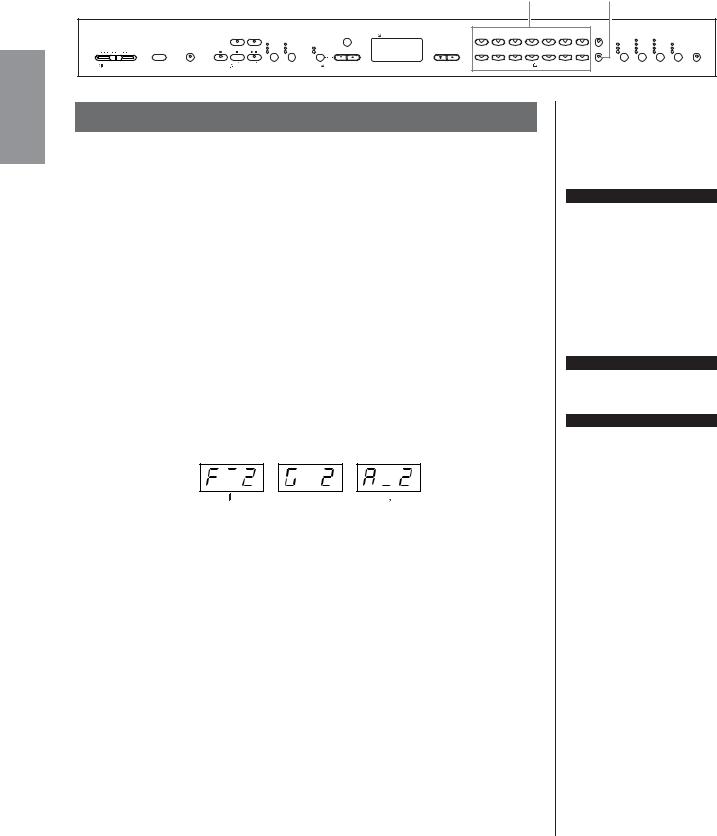
Selecting & Playing Voices
 Splitting the Keyboard Range and Playing Two Different Voices (Split mode) (CLP-240)
Splitting the Keyboard Range and Playing Two Different Voices (Split mode) (CLP-240)
Split mode enables you to play two different voices on the keyboard — one with the left hand and another with the right hand. For example, you can play a bass part using the Wood Bass or Electric Bass voice with the left hand, and a melody with the right hand.
Voice buttons |
[SPLIT] button |
ENGLISH
|
|
|
|
|
|
|
|
|
|
TEMPO/OTHER VALUE |
|
GRAND |
GRAND |
E.PIANO |
E.PIANO |
HARPSI- |
E.CLAVI- |
VIBRA- |
VARIATION |
|
|
|
|
|
|
|
|
|
LEFT |
RIGHT |
|
|
|
ON/OFF |
|
PIANO1 |
PIANO 2 |
1 |
2 |
CHORD |
CHORD |
PHONE |
|
|
|
|
|
||
|
|
|
|
|
|
|
|
|
|
|
|
|
|
|
|
|
|
|
|
|
ROOM |
CHORUS |
|
|
|
|
|
|
|
|
USB |
SAVE/EXP. |
|
|
|
|
|
|
|
|
|
|
|
|
BRIGHT |
HALL 1 |
PHASER |
HARD |
|
|
|
|
REC |
STOP |
PLAY/PAUSE |
USER |
LOAD |
TEMPO |
METRONOME |
|
–/ NO +/ YES |
CHURCH |
JAZZ |
|
|
|
WOOD |
|
|
NORMAL |
HALL 2 |
TREMOLO |
MEDIUM |
|
MIN |
MAX |
|
ON |
|
|
PRESET |
FORMAT/DEL. |
FUNCTION# |
|
|
ORGAN |
ORGAN |
STRINGS |
CHOIR |
GUITAR |
BASS |
E.BASS |
SPLIT |
MELLOW |
STAGE |
ROTARYSP |
SOFT |
ON |
|
|
MASTER VOLUME |
|
|
SYNC START |
|
|
TEMPO / FUNCTION# |
|
|
|
|
|
|
VOICE |
|
|
|
BRILLIANCE |
REVERB |
EFFECT |
TOUCH |
DDE |
||
|
DEMO |
TRANSPOSE |
SONG |
SONG SELECT |
FILE |
|
|
|
|
|
|
|
|
|
||||||||||
CLP-240
Procedure
1. Engage Split mode.
Press the [SPLIT] button so that its indicator lights. The default setting (WOOD BASS) will be selected for the left-hand voice at first.
The Function mode provides access to a number of other Split mode functions (page 50). (If you make no settings for Split mode functions, the appropriate setting will be set in each voice by default.)
2. Specify the split point (the border between the right-and left-hand range).
(The split point is initially set at the F 2 key by default.
If you do not need to change the split point, skip this procedure.)
You can change the split point to any other key by pressing the key while holding the [SPLIT] button (the name of the current split-point key appears on the LED display while the [SPLIT] button is held).
An example of split-point key display
(F 2) |
(G2) |
(A 2) |
||
|
|
|
|
|
followed by a high bar if sharp |
|
followed by a low bar if flat |
||
NOTE
Dual (page 25) and Split modes cannot be engaged simultaneously.
NOTE
A specified “split point” key is included in the left-hand range.
NOTE
The split point can also be set via Function 4 (page 50).
26 |
CLP-240/230 Owner’s Manual |
|
|

3. Select a voice for the right hand.
Press a voice button.
4. Select a voice for the left hand.
Press the corresponding voice button while holding the [SPLIT] button. (The indicator of the Left Voice button will light while the [SPLIT] button is pressed.) To turn the variation on or off for the split voice, hold the [SPLIT] button and press the [VARIATION] button or the currently-selected voice button.
5. Exit Split mode and return to normal play mode.
Press the [SPLIT] button again so that its indicator goes out.
Selecting & Playing Voices
NOTE
[VARIATION] in Split Mode
You can turn the variation on or off for Split mode voices. Normally, the voice indicator of the right voice lights in Split mode. The [VARIATION] can be used to turn the variation for the right voice on or off as required. While the [SPLIT] button is held, however, the voice indicator of the left voice lights. In this state the [VARIATION] button turns the variation for the left voice on or off.
NOTE |
ENGLISH |
|
[REVERB] in Split Mode |
||
|
||
The reverb type assigned to the |
|
|
right voice will take priority over |
|
|
the other. (If the reverb is set to |
|
|
OFF, the left voice’s reverb type |
|
|
will be in effect.) Reverb depth |
|
|
setting via the panel controls (i.e. |
|
|
pressing the [–/NO] or [+/YES] |
|
|
buttons while holding the |
|
|
[REVERB] button — see |
|
|
page 21) will be applied to the |
|
|
right voice only. |
|
|
|
|
|
NOTE |
|
|
[EFFECT] in Split Mode |
|
|
Depending on the conditions, one |
|
|
effect type will take priority over |
|
|
the other. The depth will be |
|
|
decided according to the depth |
|
|
default value of the voice combi- |
|
|
nation. However, using function |
|
|
F4 (page 50) you can change the |
|
|
depth value for each voice as you |
|
|
like. Effect depth setting via the |
|
|
panel controls (i.e. pressing the |
|
|
[–/NO] or [+/YES] buttons while |
|
|
holding the [EFFECT] button — |
|
|
see page 22) will be applied to |
|
|
the right voice only. |
|
CLP-240/230 Owner’s Manual |
27 |
|
|
